My most current blog entry:
Entries in The Sea (24)
Scotland Coastal Villages - Banff and MacDuff
 Tuesday, June 21, 2016 at 4:21AM
Tuesday, June 21, 2016 at 4:21AM  Here I am again . . . tagging along with my wife on her golf tournament. I dropped her off at Duff House Royal Golf Club and set off for a little photographic expedition to the coastal villeges nearby: Banff and MacDuff. This is the village center of Banff.
Here I am again . . . tagging along with my wife on her golf tournament. I dropped her off at Duff House Royal Golf Club and set off for a little photographic expedition to the coastal villeges nearby: Banff and MacDuff. This is the village center of Banff.
 Banff is a very old village. It had its first castle in 1163, build to repel the invading Vikings.
Banff is a very old village. It had its first castle in 1163, build to repel the invading Vikings.
 Banff is a more prosperous village. It was a trading center until the 1770s, when a port was constructed.
Banff is a more prosperous village. It was a trading center until the 1770s, when a port was constructed.
 Banff is built up the side of a rather steel hill that rises up from a broad bay. There are still narrow walking paths that give the only access to quaint cottages.
Banff is built up the side of a rather steel hill that rises up from a broad bay. There are still narrow walking paths that give the only access to quaint cottages.
 A typical 17th century house in Banff.
A typical 17th century house in Banff.
 Banff is a lovely village. It is just big enough to offer all the amenities, but small enough to still feel like a village. I could see living in this house (it's for sale) on street off the bay.
Banff is a lovely village. It is just big enough to offer all the amenities, but small enough to still feel like a village. I could see living in this house (it's for sale) on street off the bay.
 There are a couple of scaled-down 'supermarkets' in Banff, but the downtown is still vibrant, owing to the fact that the nearest mall is 50 miles away.
There are a couple of scaled-down 'supermarkets' in Banff, but the downtown is still vibrant, owing to the fact that the nearest mall is 50 miles away.
 There are several quaint old hotels in town.
There are several quaint old hotels in town.
 I couldn't resist snooping around the fascinating old cemetery . . . right in the middle of the village.
I couldn't resist snooping around the fascinating old cemetery . . . right in the middle of the village.
 I come from a very wet place (Western Oregon in the USA), so I understand this kind of moss.
I come from a very wet place (Western Oregon in the USA), so I understand this kind of moss.
 There were several extraordinary crypts and carved grave covers.
There were several extraordinary crypts and carved grave covers.
 Just so your survivors wouldn't have to wonder what happened to you . . . you put a skull and bones on your grave marker. [Note to self: do not have horizontal grave stone in rainy environment.]
Just so your survivors wouldn't have to wonder what happened to you . . . you put a skull and bones on your grave marker. [Note to self: do not have horizontal grave stone in rainy environment.]
 I decided to walk back through old town Banff toward the sea and the jetty. These are the oldest continuously inhabited buildings in Banff, dating from the mid-14th century.
I decided to walk back through old town Banff toward the sea and the jetty. These are the oldest continuously inhabited buildings in Banff, dating from the mid-14th century.
 Being such a very old village, there were, of course, a few buildings that were in full deterioration. My favorite photo subject!
Being such a very old village, there were, of course, a few buildings that were in full deterioration. My favorite photo subject!
 House number 30.
House number 30.
 I love the story of time and weather written on these old, unattended, doors.
I love the story of time and weather written on these old, unattended, doors.
 House number 32. Nobody home.
House number 32. Nobody home.
 The sea wall at high tide. I followed the wall out to the jetty next to a raging North Sea.
The sea wall at high tide. I followed the wall out to the jetty next to a raging North Sea.
 Crabbing and shrimping pots lined the old stone jetty.
Crabbing and shrimping pots lined the old stone jetty.
 I studied these for a few minutes, imagining myself as a crab, but I couldn't work out how these thing worked.
I studied these for a few minutes, imagining myself as a crab, but I couldn't work out how these thing worked.
 View from the jetty: A broad bay separates Banff from the even smaller village of MacDuff, seen on the horizon. This is where the River Deveron estuary ends in the North Sea.
View from the jetty: A broad bay separates Banff from the even smaller village of MacDuff, seen on the horizon. This is where the River Deveron estuary ends in the North Sea.
 Ther is a small light at the end of the jetty. At high tide the waves occasionally break over sea wall.
Ther is a small light at the end of the jetty. At high tide the waves occasionally break over sea wall.
 I was getting hungry, so I took a different street back to my car. I passed this relic of days gone bye.
I was getting hungry, so I took a different street back to my car. I passed this relic of days gone bye.
 I often ask myself, what is it about old doors that compel me to take a photograph? Something about mortality, I believe.
I often ask myself, what is it about old doors that compel me to take a photograph? Something about mortality, I believe.
 I made my way back to the village center and then on up the steep hill to a nice cafe and had a bowl of Cullen Skink, a scone, and a cup of coffee.
I made my way back to the village center and then on up the steep hill to a nice cafe and had a bowl of Cullen Skink, a scone, and a cup of coffee.
 After lunch I decided to find the castle whose sign I saw driving in. My GPS said there was a castle only four miles away. I ended up on this gravel road through a beautiful wood.
After lunch I decided to find the castle whose sign I saw driving in. My GPS said there was a castle only four miles away. I ended up on this gravel road through a beautiful wood.
 I knew I was getting close to a castle when I started to see the old outbuildings.
I knew I was getting close to a castle when I started to see the old outbuildings.
 I love these old abandoned stone houses. I have a fantasy each time of fixing it up and living in it.
I love these old abandoned stone houses. I have a fantasy each time of fixing it up and living in it.
 Now I knew I was getting close . . . a castle gate house . . . and occupied too.
Now I knew I was getting close . . . a castle gate house . . . and occupied too.
 AH! There it is. A castle through the trees. I was not sure if this particular castle was occupied by the laird, or was open to the public. I was a little concerned someone would run our and yell at me that I was trespassing.
AH! There it is. A castle through the trees. I was not sure if this particular castle was occupied by the laird, or was open to the public. I was a little concerned someone would run our and yell at me that I was trespassing.
 I stayed back in the trees, just in case . . .
I stayed back in the trees, just in case . . .
 Magnificent and stately Craigston Castle, built in 1604. As it turns out, you can stay in this castle as a "luxury self-catering vacation home." No kidding. You can make a booking here.
Magnificent and stately Craigston Castle, built in 1604. As it turns out, you can stay in this castle as a "luxury self-catering vacation home." No kidding. You can make a booking here.
 I left the castle for a short drive to the harbour village of MacDuff. We stayed in this village right after we moved to Scotland. In fact, it was the first over night stay we made.
I left the castle for a short drive to the harbour village of MacDuff. We stayed in this village right after we moved to Scotland. In fact, it was the first over night stay we made.
 MacDuff has a proper shipyard for refitting fishing boats.
MacDuff has a proper shipyard for refitting fishing boats.
 Shipyards are visually intereting places. What in the world are these sharpened steel 'blades' used for? I have no idea.
Shipyards are visually intereting places. What in the world are these sharpened steel 'blades' used for? I have no idea.
 The rust was thick, but the pattern and color was captivating.
The rust was thick, but the pattern and color was captivating.
 Nice clean and newly painted fishing boats. I got lucky as the sun finally came out in the afternoon.
Nice clean and newly painted fishing boats. I got lucky as the sun finally came out in the afternoon.
 I could have stayed all day in the MacDuff shipyards, but my wife called to say her round was over. Great idea to affix these benches inside the seawall.
I could have stayed all day in the MacDuff shipyards, but my wife called to say her round was over. Great idea to affix these benches inside the seawall.
 We drove on the A947 back to Aberdeen. We passed a sign for Fyvie Castle . . . and I couldn't resist going in. My wife hadn't been before.
We drove on the A947 back to Aberdeen. We passed a sign for Fyvie Castle . . . and I couldn't resist going in. My wife hadn't been before.
 Fyvie castle is a proper castle. Built in 1211, Fyvie was the site of an open-air court held by Robert the Bruce, and Charles I lived there as a child.
Fyvie castle is a proper castle. Built in 1211, Fyvie was the site of an open-air court held by Robert the Bruce, and Charles I lived there as a child.
 Fyvie Castle was closed, but the vast grounds and gardens were opened. I will post more from the fabulous gardens soon.
Fyvie Castle was closed, but the vast grounds and gardens were opened. I will post more from the fabulous gardens soon.
Scotland - Outer Hebrides, Summer 2015
 Sunday, June 5, 2016 at 1:47AM
Sunday, June 5, 2016 at 1:47AM  Our explorations of the west of Scotland often begin in the port and ferry terminal city of Oban. It is a beautiful old town . . . and also has the best oysters in Scotland.
Our explorations of the west of Scotland often begin in the port and ferry terminal city of Oban. It is a beautiful old town . . . and also has the best oysters in Scotland.
 I love the old fishing trawlers at the quay in Oban, mostly because I am rust obsessed.
I love the old fishing trawlers at the quay in Oban, mostly because I am rust obsessed.
 Working boats . . . working for our seafood.
Working boats . . . working for our seafood.
 We took the ferry from Oban to the Outer Hebrides, a four hour trip.
We took the ferry from Oban to the Outer Hebrides, a four hour trip.
 The ferry left Oban though the Sound of Mull. The view of the Isle of Mull was spectacular.
The ferry left Oban though the Sound of Mull. The view of the Isle of Mull was spectacular.
 We arrived on the Outer Hebrides on Barra island, in the town of Castlebay, named after the 16th century Kisimul Castle in the bay.
We arrived on the Outer Hebrides on Barra island, in the town of Castlebay, named after the 16th century Kisimul Castle in the bay.
 Most of the Hebrides were depopulated in the 1950s. There were plenty of old abandoned buildings to photograph.
Most of the Hebrides were depopulated in the 1950s. There were plenty of old abandoned buildings to photograph.
 The Outer Hebrides are very remote, one of the most remote places in Europe. We were here at the very beginning of the tourist season and not everything wad open yet . . . some for unforeseen circumstances.
The Outer Hebrides are very remote, one of the most remote places in Europe. We were here at the very beginning of the tourist season and not everything wad open yet . . . some for unforeseen circumstances.
 We drove north up the A888, a mostly one-lane road with passing pull-outs every now and then. The otherworldly rocky landscape was fascinating.
We drove north up the A888, a mostly one-lane road with passing pull-outs every now and then. The otherworldly rocky landscape was fascinating.
 A Barra beach.
A Barra beach.
 The chain of Islands are connected by a few bridges and several ferries. We left Barra for Eriskay (old Norse of "Eric's Island") and South Uist islands. In the 2011 census South Uist had a usually resident population of 1,754.
The chain of Islands are connected by a few bridges and several ferries. We left Barra for Eriskay (old Norse of "Eric's Island") and South Uist islands. In the 2011 census South Uist had a usually resident population of 1,754.
 Getting to the ferries early allows time for photography . . . and a cup of coffee in the tiny terminal.
Getting to the ferries early allows time for photography . . . and a cup of coffee in the tiny terminal.
 The ferry passage between islands under the leaden skies and misty sounds created a fine dark mood.
The ferry passage between islands under the leaden skies and misty sounds created a fine dark mood.
 South Uist island is home of the Askernish Golf Course, designed by Old Tom Morris (in 1891), the same course designer of the Old Course at St. Andrews. The Askernish Golf course was 'lost' for over 80 years until re-discovered and reopened in 2008.
South Uist island is home of the Askernish Golf Course, designed by Old Tom Morris (in 1891), the same course designer of the Old Course at St. Andrews. The Askernish Golf course was 'lost' for over 80 years until re-discovered and reopened in 2008.
 The fields of South Uist we all abloom in yellow flowers.
The fields of South Uist we all abloom in yellow flowers.
 From South Uist we passed over a causeway to Benbecula island and then across another causeway to North Uist Island. We followed this road to Lochmaddy, where the ferry to the Isle of Skye terminates.
From South Uist we passed over a causeway to Benbecula island and then across another causeway to North Uist Island. We followed this road to Lochmaddy, where the ferry to the Isle of Skye terminates.
 We had a fine lunch at the port of Lochmaddy and afterward I walked along the fishing pier at low tide to capture some still life photos.
We had a fine lunch at the port of Lochmaddy and afterward I walked along the fishing pier at low tide to capture some still life photos.
 Grey rope and grey stone.
Grey rope and grey stone.
 I found a wad of bright orange kelp and took many photos. I use this (in full resolution) as a desktop photo. Fascinating.
I found a wad of bright orange kelp and took many photos. I use this (in full resolution) as a desktop photo. Fascinating.
 Although we had very little clear skies, we also had very little rain. A threatening storm approaches . . . then fizzled.
Although we had very little clear skies, we also had very little rain. A threatening storm approaches . . . then fizzled.
 To say that the Outer Hebrides is a wet and cloudy place is an understatement.
To say that the Outer Hebrides is a wet and cloudy place is an understatement.
 Always wet, always damp, always rocky, always peaty.
Always wet, always damp, always rocky, always peaty.
 The Outer Hebrides is such a completely different environment from any I have ever seen.
The Outer Hebrides is such a completely different environment from any I have ever seen.
 There is some agriculture and husbandry out on the Outer Hebrides. These are Highland cows.
There is some agriculture and husbandry out on the Outer Hebrides. These are Highland cows.
 We made another small ferry passage from North Uist to the Isle of Harris, the home of the famous Harris Tweed.
We made another small ferry passage from North Uist to the Isle of Harris, the home of the famous Harris Tweed.
 We made a beautiful landing on Harris.
We made a beautiful landing on Harris.
 More beautiful fishing boats on Harris.
More beautiful fishing boats on Harris.

Nothing like the beach on a beautiful summer day in the tropics . . . but wait! This is the Isle of Harris in the Outer Hebrides, an island chain a hundred miles off the far northwest shores of Scotland!
 Being Scotland in the summer, we were just happy that it wasn't actually raining. The clouds are no problem. In fact, during the 10 days we spent on this trip to the Outer Hebrides from Aberdeen, we saw actual rain only once.
Being Scotland in the summer, we were just happy that it wasn't actually raining. The clouds are no problem. In fact, during the 10 days we spent on this trip to the Outer Hebrides from Aberdeen, we saw actual rain only once.
 Most of the roads we drove on the Hebridean Isles were one-lane. It seemed we were never more than a few hundred yards from the sea . . . and views of coves, beaches, and cliffs.
Most of the roads we drove on the Hebridean Isles were one-lane. It seemed we were never more than a few hundred yards from the sea . . . and views of coves, beaches, and cliffs.
 Oh! The views!
Oh! The views!
 Brooks and streams pouring into the sea from every hill and mountain.
Brooks and streams pouring into the sea from every hill and mountain.
 The Isle of Harris and the Isle of Lewis are conjoined. Crossing them several times, we were taken with the grand views of this dramatic landscape. The stripes are the remnants of peat cutting, or harvesting.
The Isle of Harris and the Isle of Lewis are conjoined. Crossing them several times, we were taken with the grand views of this dramatic landscape. The stripes are the remnants of peat cutting, or harvesting.
 Peat (turf) is an accumulation of partially decayed vegetation or organic matter that is unique to natural areas called peatlands, bogs, or mires. The peat is cut off from banks and left to dry, or drain. Peat, when dry, is slow burning (and smelly!), and has been used to heat homes in remote Scotland for centuries.
Peat (turf) is an accumulation of partially decayed vegetation or organic matter that is unique to natural areas called peatlands, bogs, or mires. The peat is cut off from banks and left to dry, or drain. Peat, when dry, is slow burning (and smelly!), and has been used to heat homes in remote Scotland for centuries.
 We saw many seals basking on the rocks from our several ferry trips, and abundant birds everywhere, but this rabbit was the only land mammal we saw.
We saw many seals basking on the rocks from our several ferry trips, and abundant birds everywhere, but this rabbit was the only land mammal we saw.
 Only a few traditional old thatched houses remain on the Outer Hebrides.
Only a few traditional old thatched houses remain on the Outer Hebrides.
 Old shepherd's sheds dotted the high bogs of Lewis.
Old shepherd's sheds dotted the high bogs of Lewis.
 The Callinish Stones as we first saw them. There are many prehistoric sites all about the Outer Hebrides, but the Isles of Harris and Lewis have the most. Magnificent.
The Callinish Stones as we first saw them. There are many prehistoric sites all about the Outer Hebrides, but the Isles of Harris and Lewis have the most. Magnificent.
 Although this Neolithic site dates from before 3000 BC, the standing stones date from 2900-2600 BC. The Standing Stones of Callinish are a complex of neolithic structures, including a burial chamber (closed the day we were here).
Although this Neolithic site dates from before 3000 BC, the standing stones date from 2900-2600 BC. The Standing Stones of Callinish are a complex of neolithic structures, including a burial chamber (closed the day we were here).
 The light came and went all afternoon, creating a drama of different moods across the stone circle.
The light came and went all afternoon, creating a drama of different moods across the stone circle.
 The view from the mound of standing stones was inspirational.
The view from the mound of standing stones was inspirational.
MORE TO COME: STILL CONSTRUCTING THIS ENTRY.
 The Hebridean landscape lends itself to fancy photographic effects . . . .
The Hebridean landscape lends itself to fancy photographic effects . . . .
Scotland - Fraserburgh
 Sunday, May 15, 2016 at 5:20AM
Sunday, May 15, 2016 at 5:20AM It's nice when my wife has a golf tournament out of town . . . I get to drive here there and then explore the area around Fraserburgh.
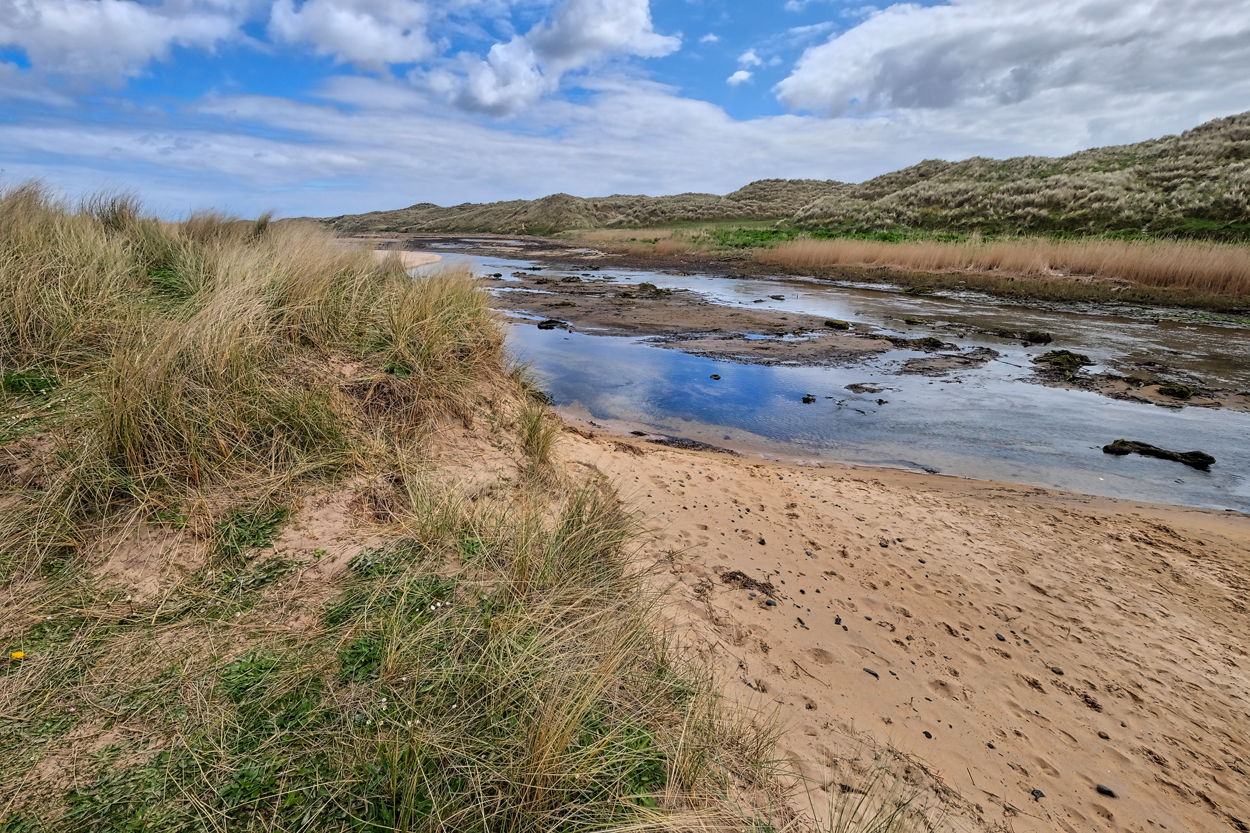 The Waters of Philorth.
The Waters of Philorth.
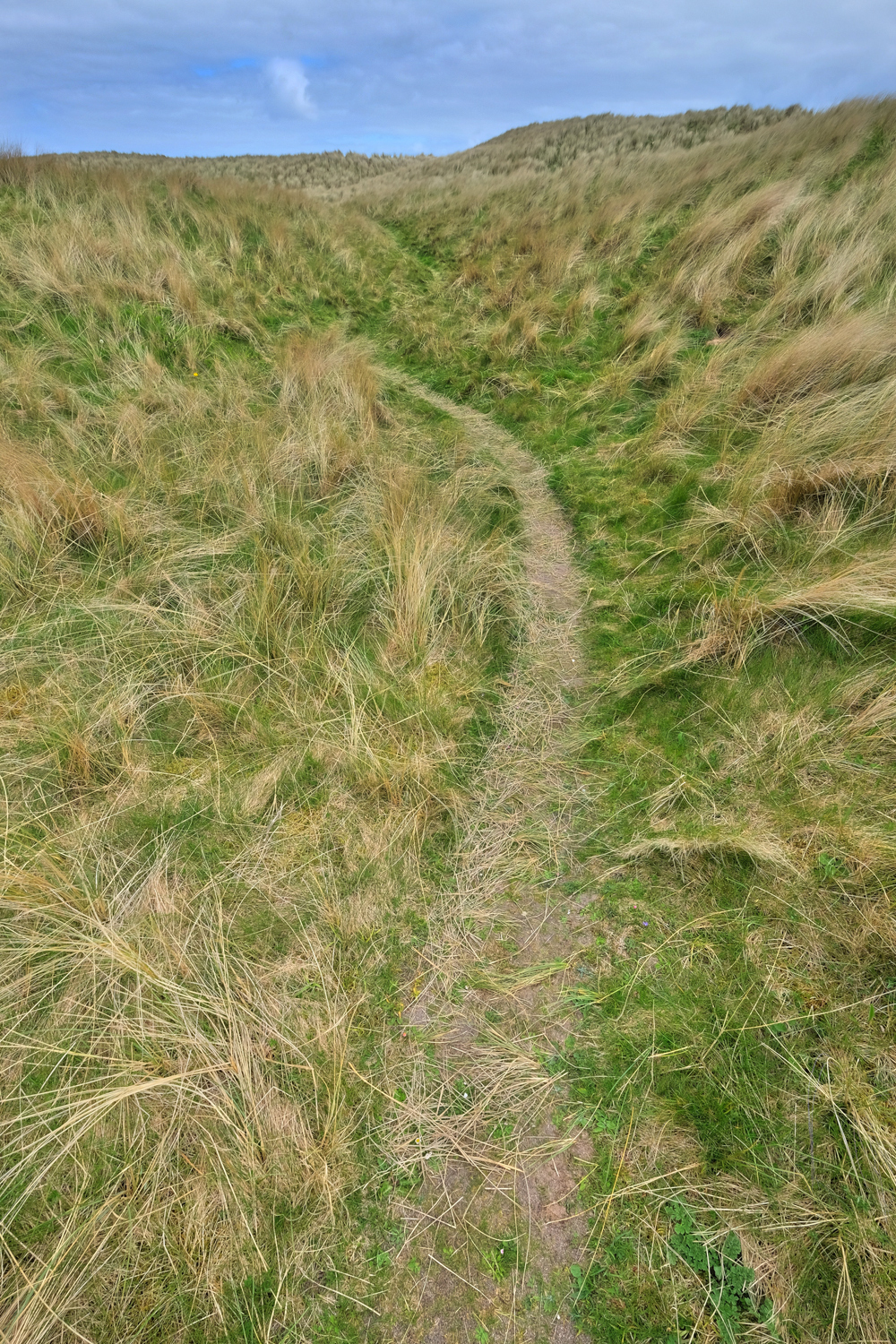 Fraserburgh Golf Club is the 7th oldest golf course in the world, having been founded in 1777. It sits among the dunes on the Scottish Aberdeenshire Coast.
Fraserburgh Golf Club is the 7th oldest golf course in the world, having been founded in 1777. It sits among the dunes on the Scottish Aberdeenshire Coast.
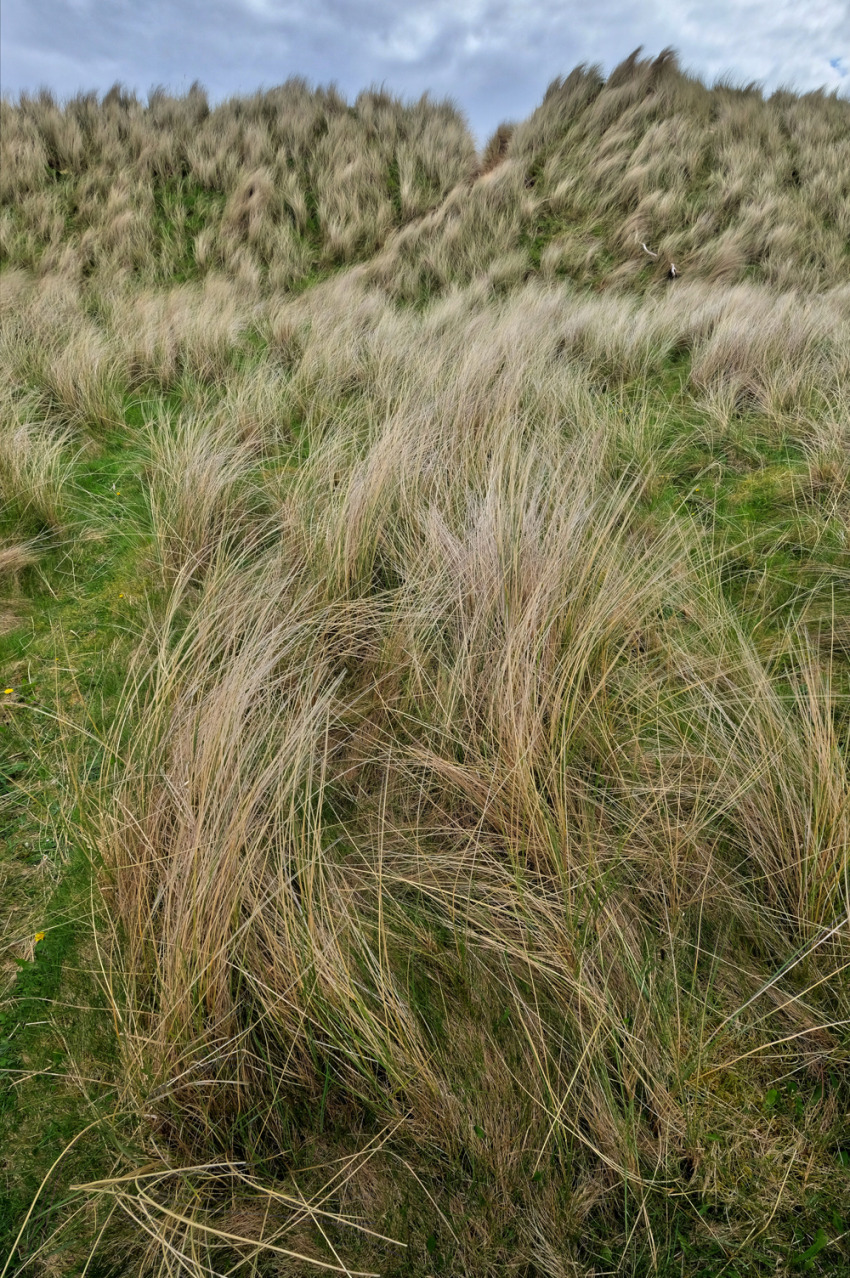 The sea breeze was strong along the tops of the dunes, but calm down in the deep sandy hollows.
The sea breeze was strong along the tops of the dunes, but calm down in the deep sandy hollows.
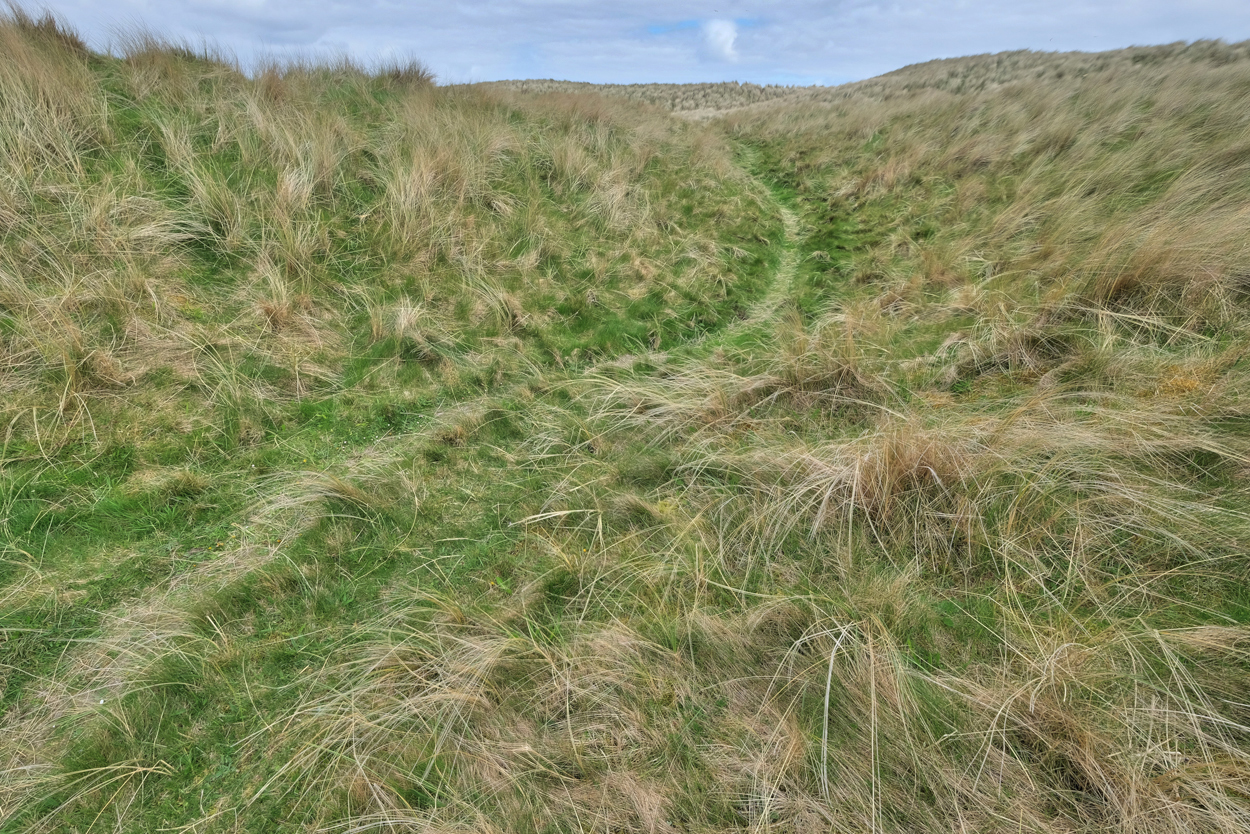 Walking the dune trails had a mystical quality to me . . .
Walking the dune trails had a mystical quality to me . . .
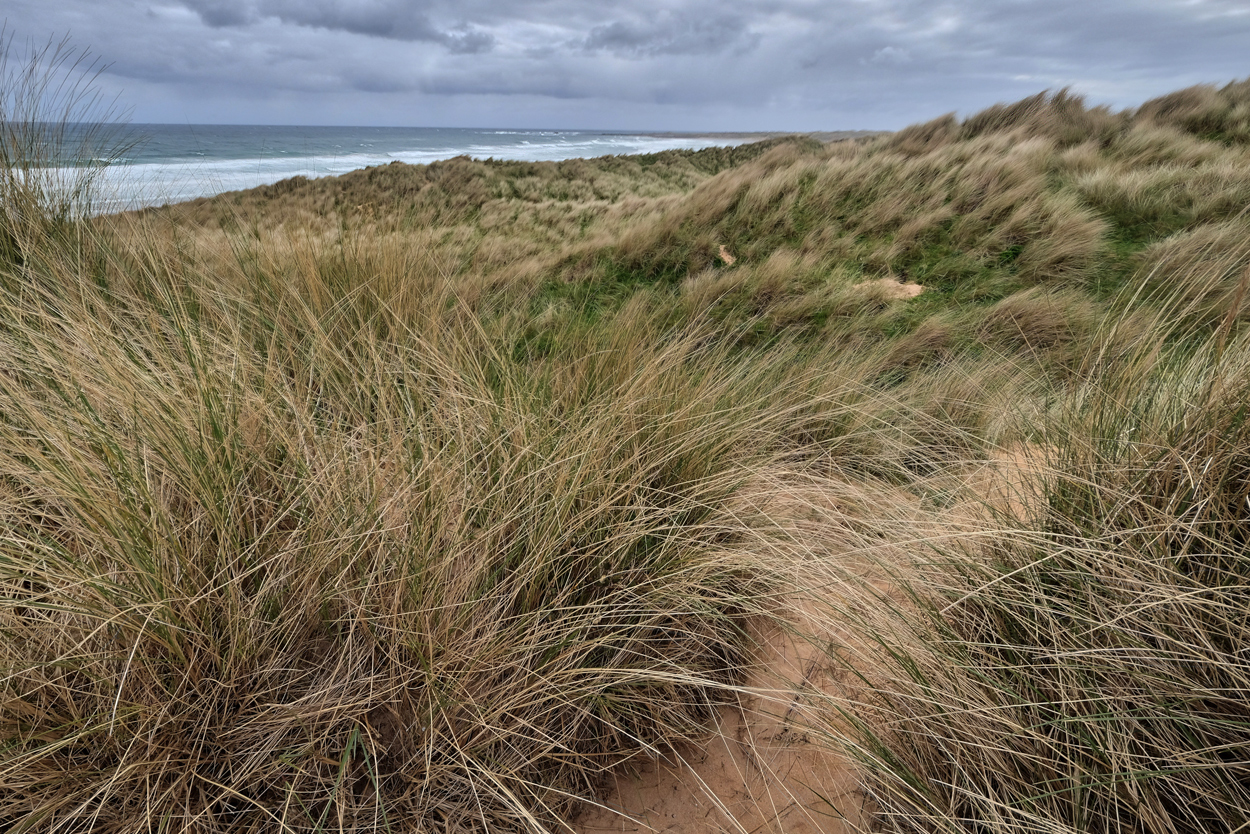 I crested a dune to find the North Sea . . . and miles of beach.
I crested a dune to find the North Sea . . . and miles of beach.
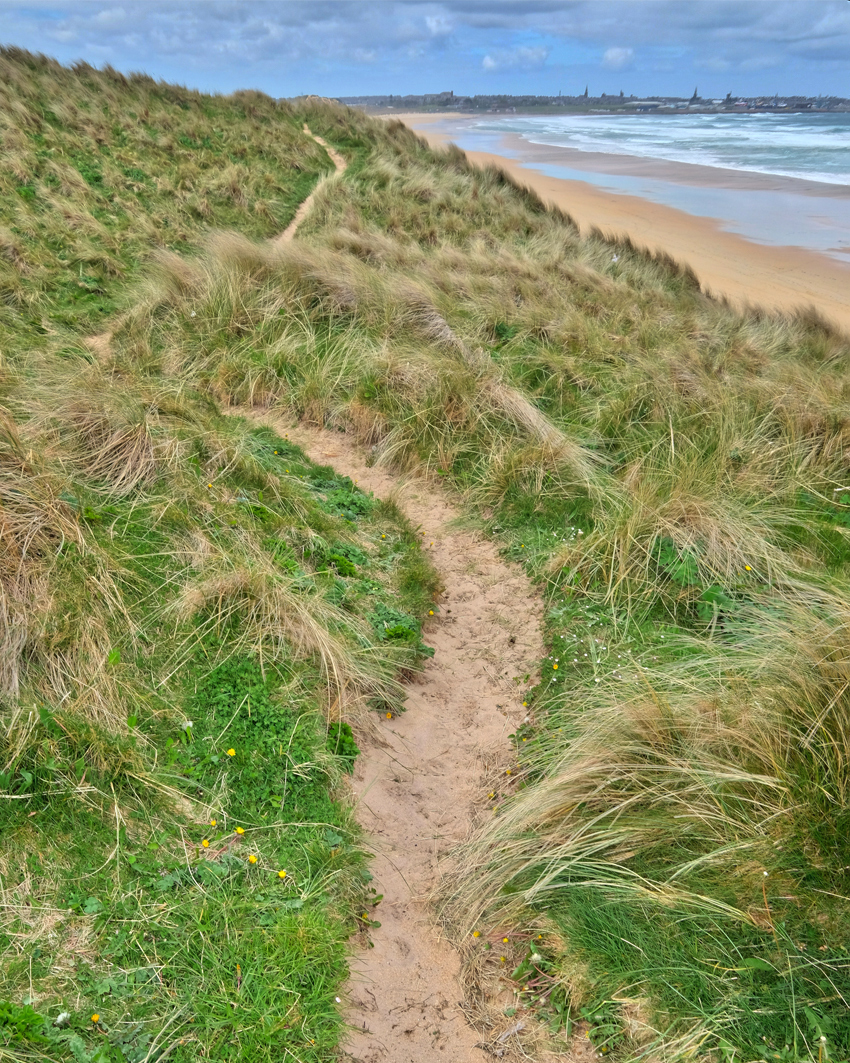 I looked left to the town of Fraserburgh, trying to decide which way to go . . .
I looked left to the town of Fraserburgh, trying to decide which way to go . . .
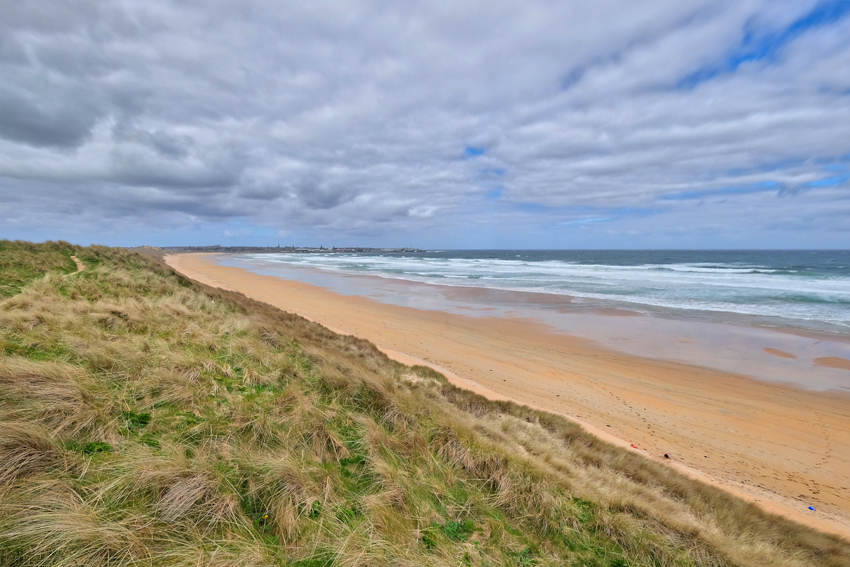 Although walking east toward Fraserburgh looked inviting . . .
Although walking east toward Fraserburgh looked inviting . . .
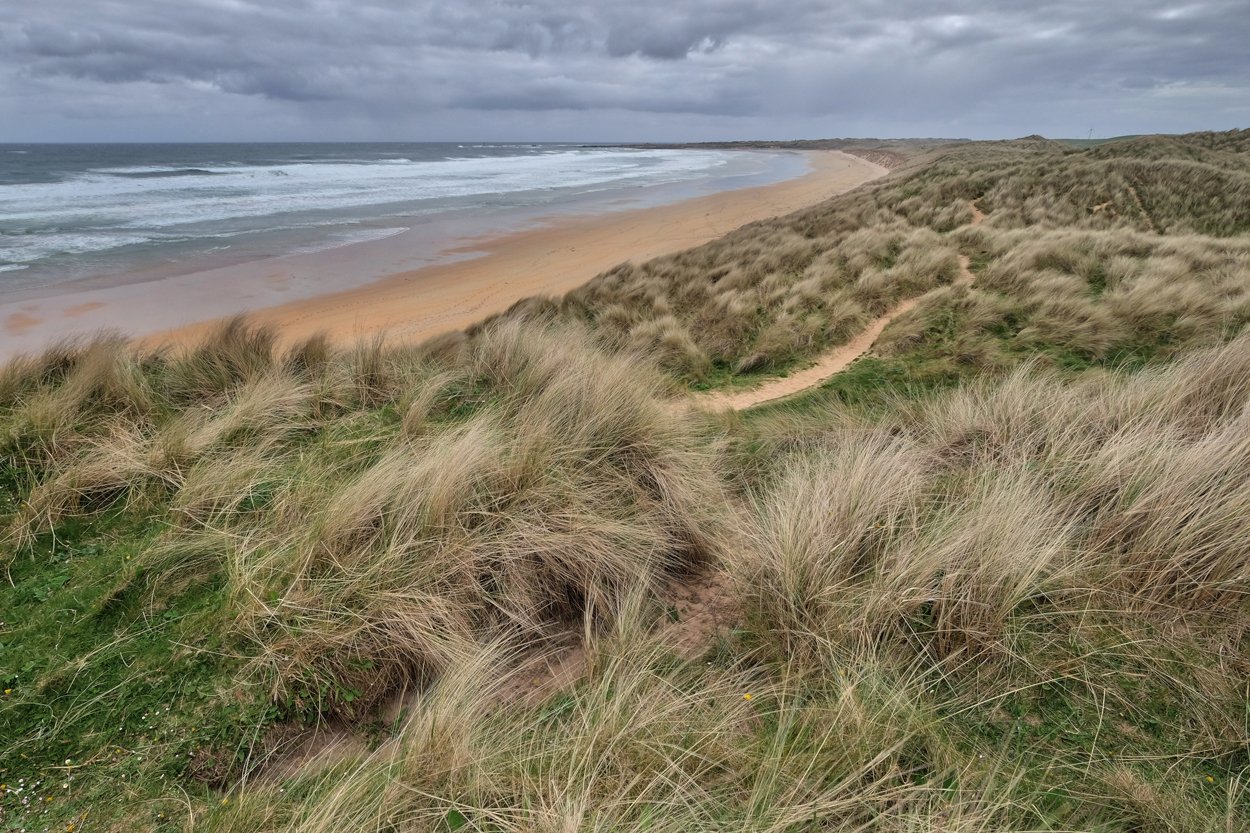 I decided to walk west toward the next village, Inverallochy, and what looked like a ship wreck. I wandered around in the web of sandy trails looking for a way down the embankments to the broad beach.
I decided to walk west toward the next village, Inverallochy, and what looked like a ship wreck. I wandered around in the web of sandy trails looking for a way down the embankments to the broad beach.
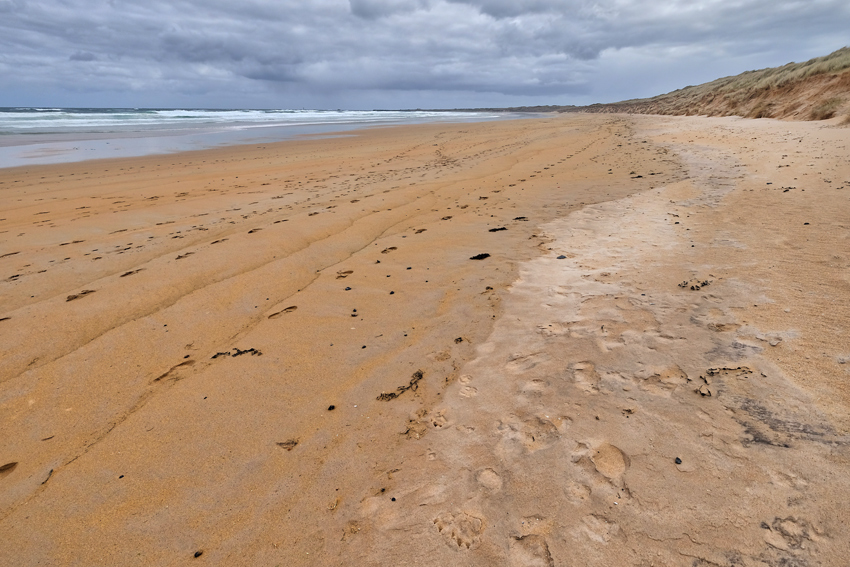 There were beachcombers on the broad Fraserburgh beach.
There were beachcombers on the broad Fraserburgh beach.
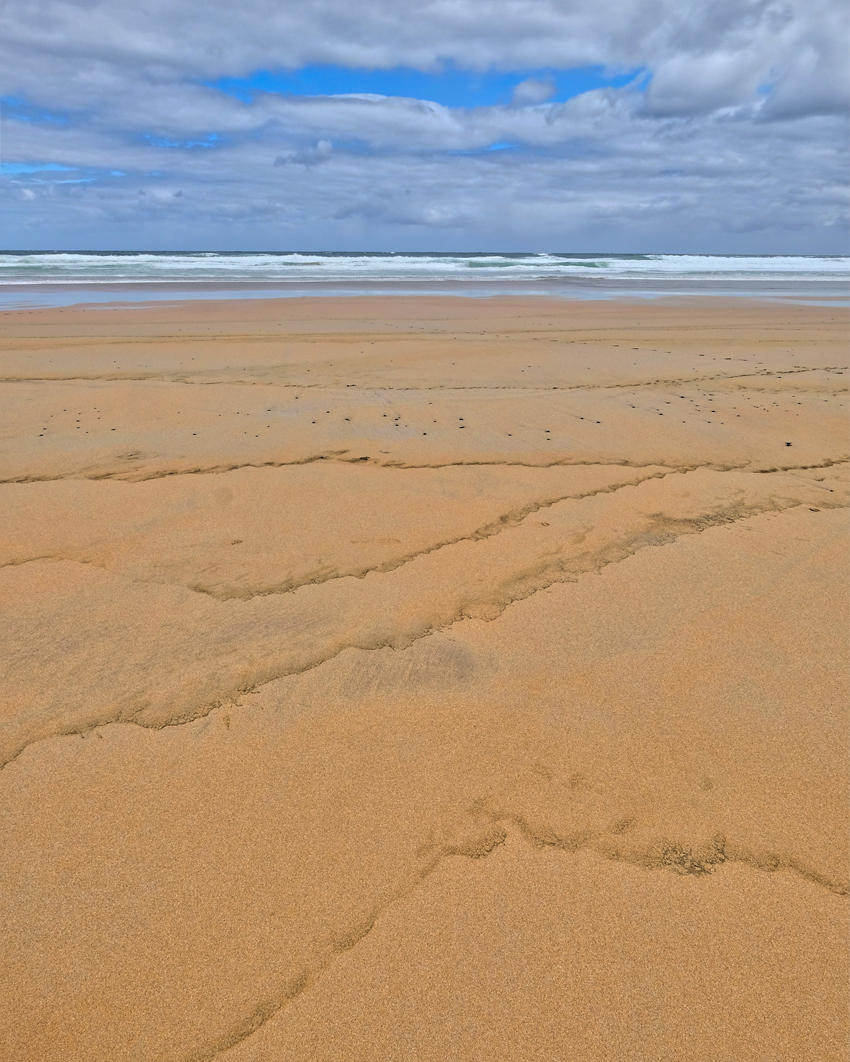 Fascinating patterns in the sand to look at.
Fascinating patterns in the sand to look at.
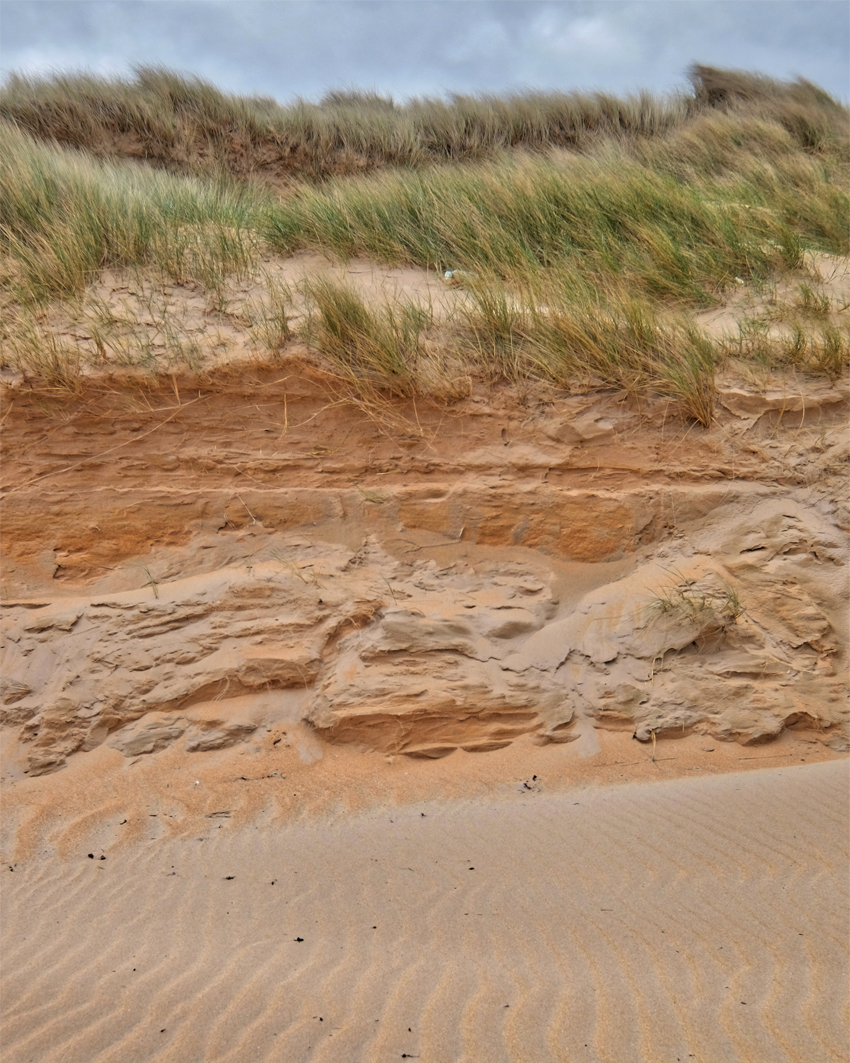 As sea level rises, the beach dunes are eroded.
As sea level rises, the beach dunes are eroded.
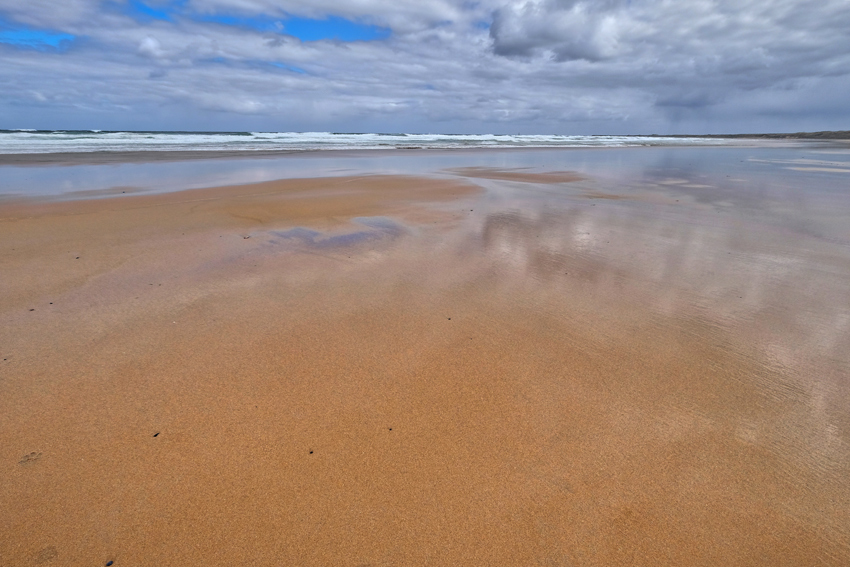 Beach, sea, sky . . . looking like a tropical paradise, but at 5c, not exactly tropical.
Beach, sea, sky . . . looking like a tropical paradise, but at 5c, not exactly tropical.
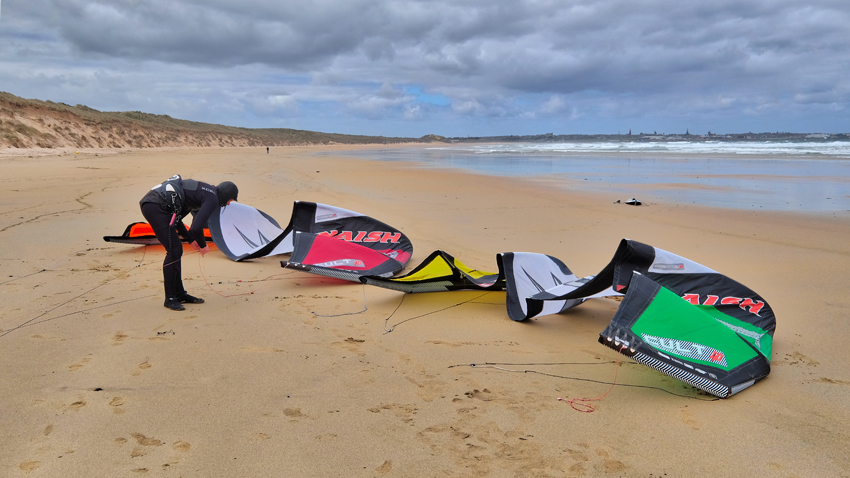 I wasn't the o nly person out on such a fine and windy day . . . these brave wind surfers were preparing for their brand of fun. I must add; the wind was very cold.
I wasn't the o nly person out on such a fine and windy day . . . these brave wind surfers were preparing for their brand of fun. I must add; the wind was very cold.
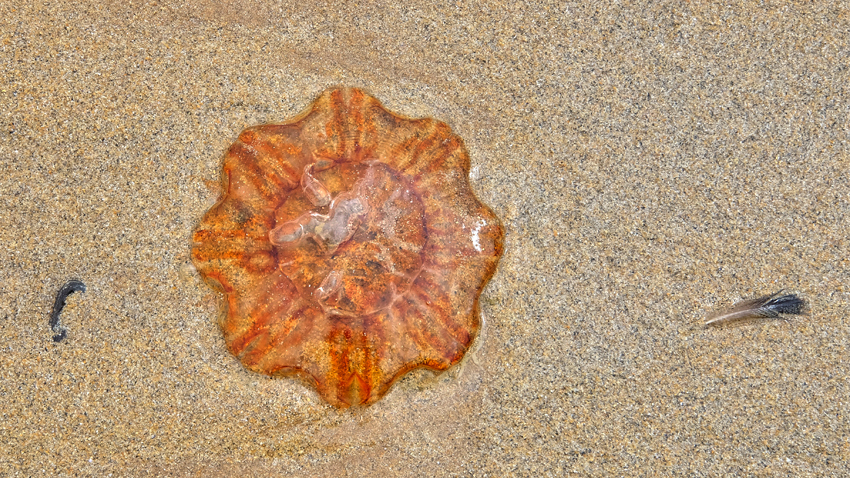 Jellyfish and feather.
Jellyfish and feather.
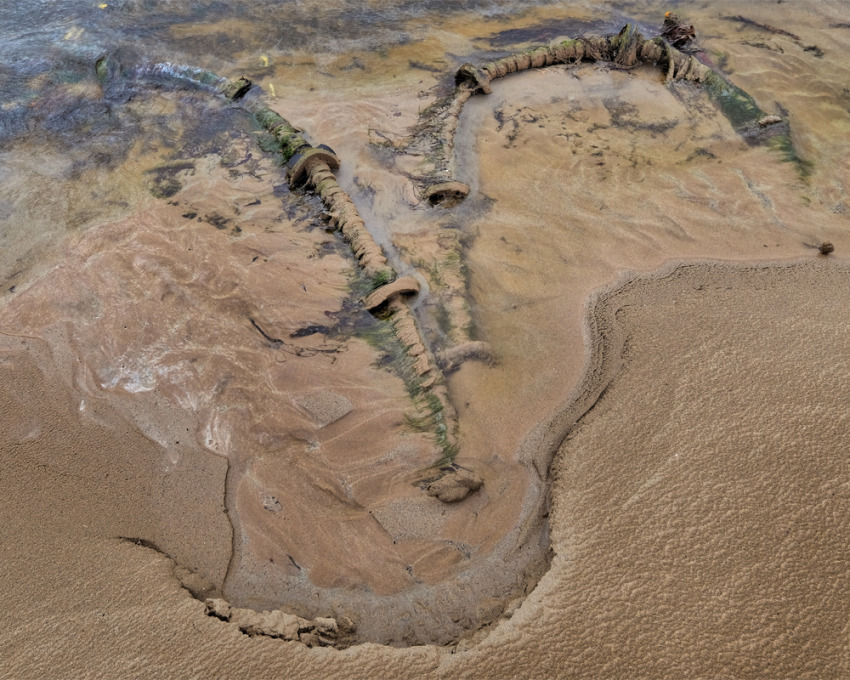 A beach combing find from somewhere far off in the North Sea.
A beach combing find from somewhere far off in the North Sea.
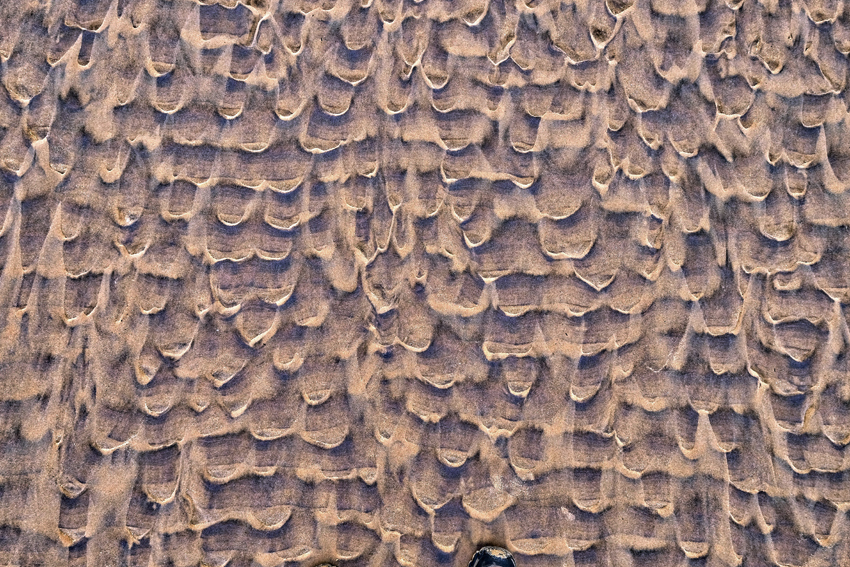 Such a broad beach creates wonderful patterns as the tide recedes.
Such a broad beach creates wonderful patterns as the tide recedes.
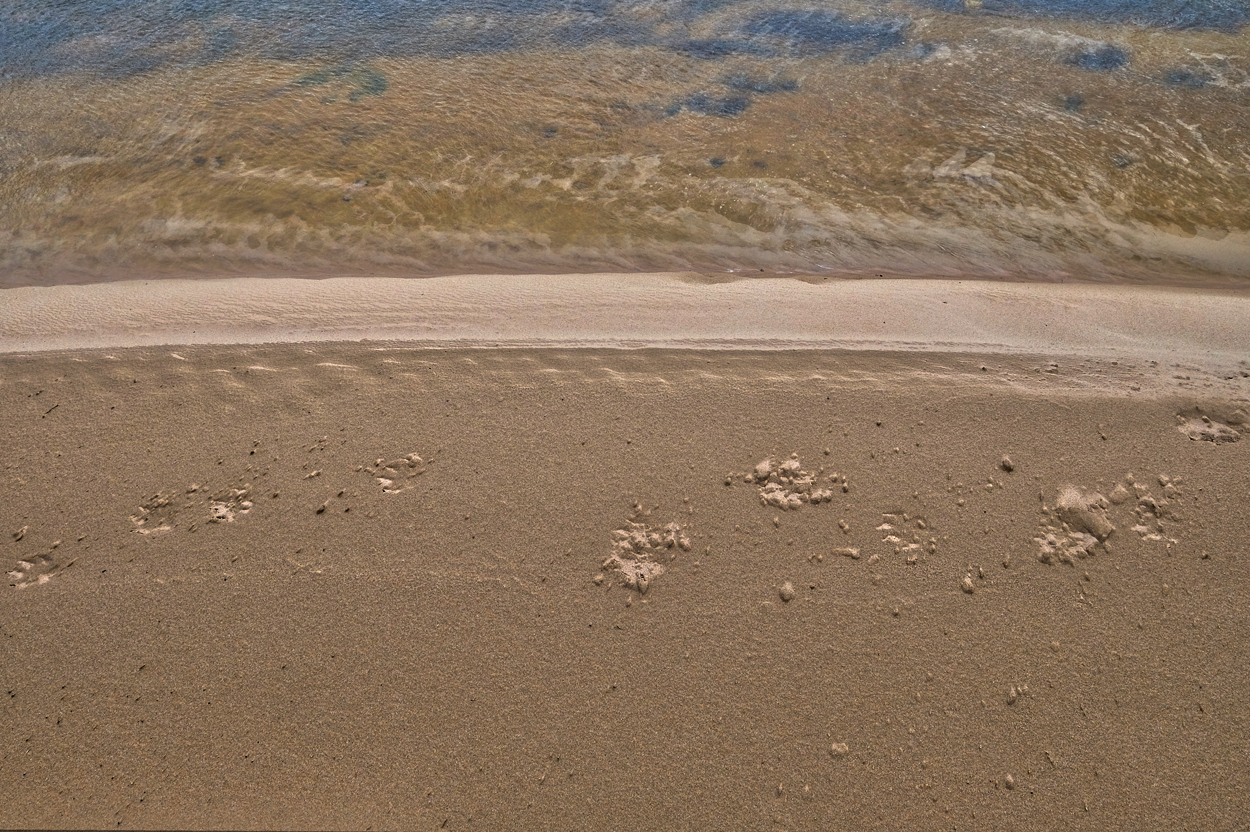 Where the beach met a fast moving burn, a set of contrasting shapes, textures, and colors met in a happy collision.
Where the beach met a fast moving burn, a set of contrasting shapes, textures, and colors met in a happy collision.
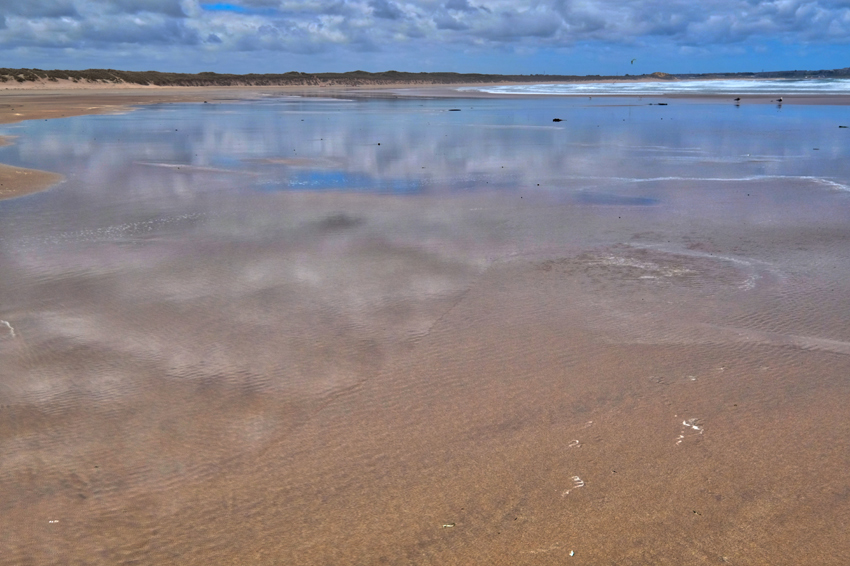 I walked all the way to the end of the beach . . .
I walked all the way to the end of the beach . . .
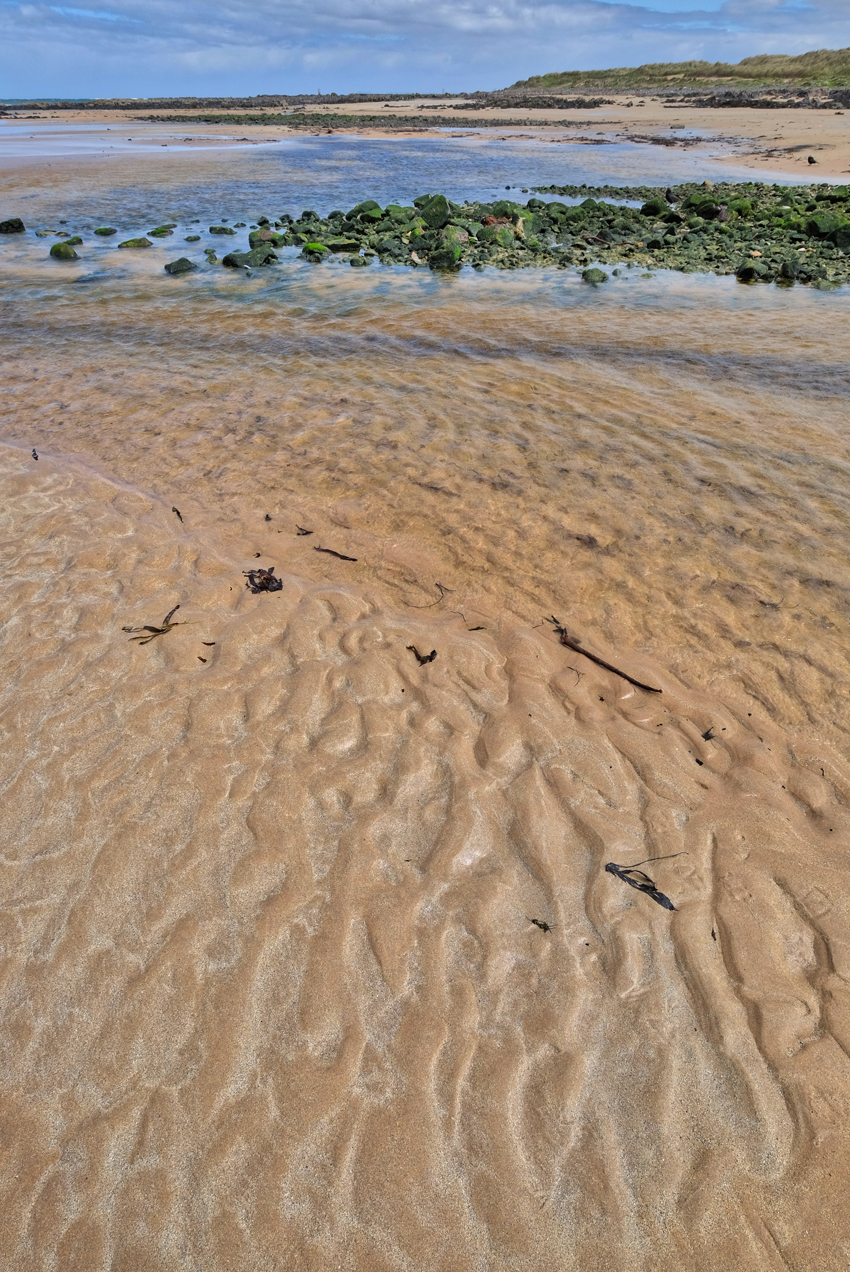 I arrived at the estuary of the Waters of Philorth, but could not find a way across the swift and deep waters without getting my feet wet.
I arrived at the estuary of the Waters of Philorth, but could not find a way across the swift and deep waters without getting my feet wet.
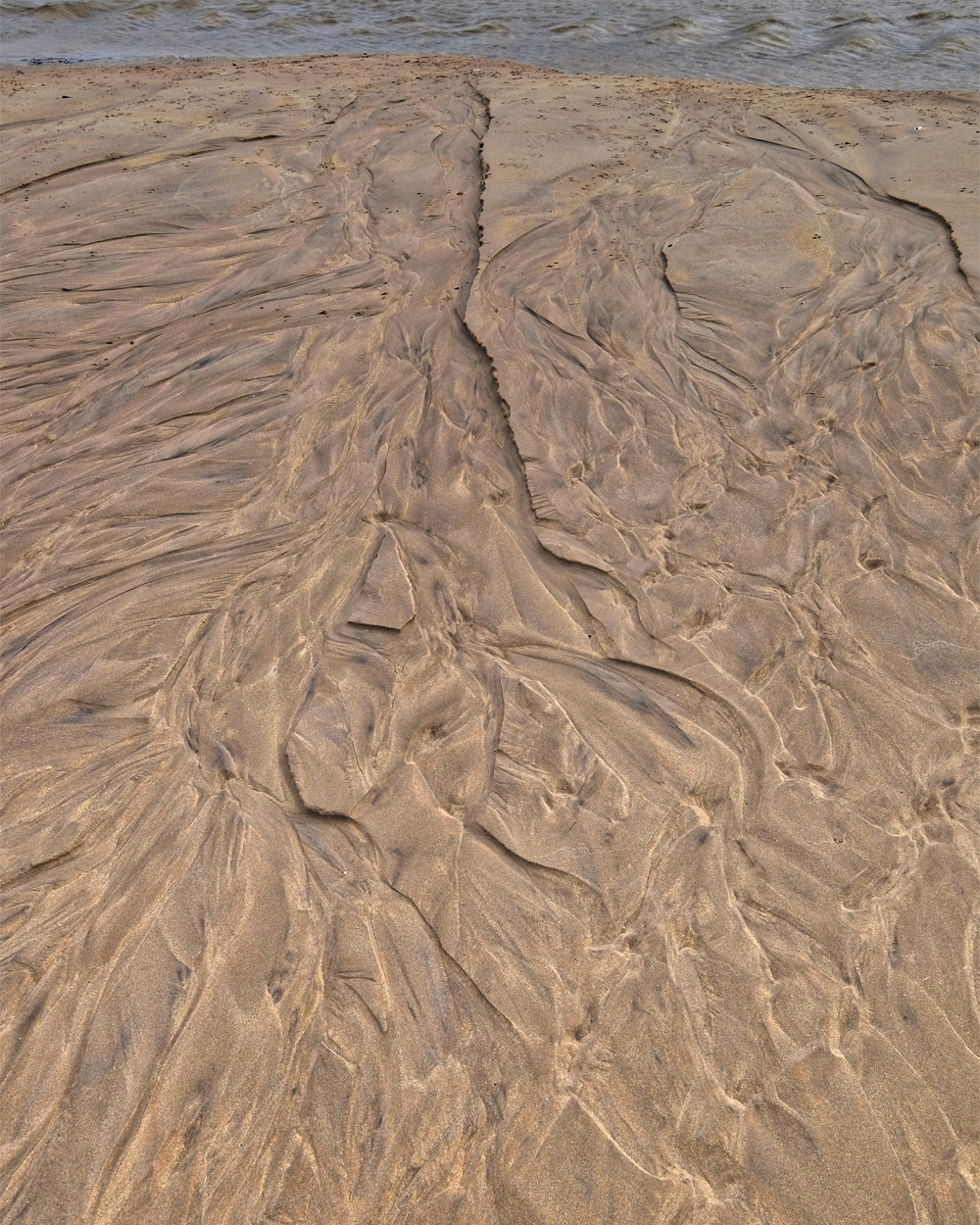 The last big wave drained into the burn this way.
The last big wave drained into the burn this way.
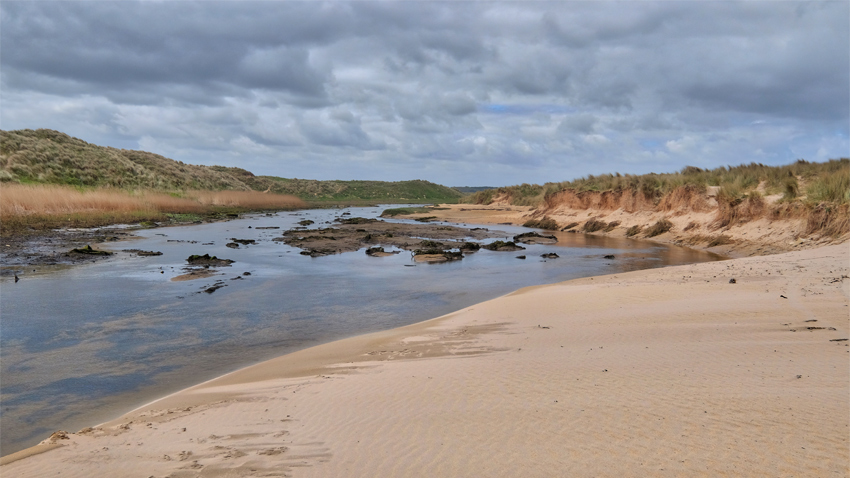 I didn't want to go back the way I came, so I walked inland along the stream knowing I would eventually run into the road.
I didn't want to go back the way I came, so I walked inland along the stream knowing I would eventually run into the road.
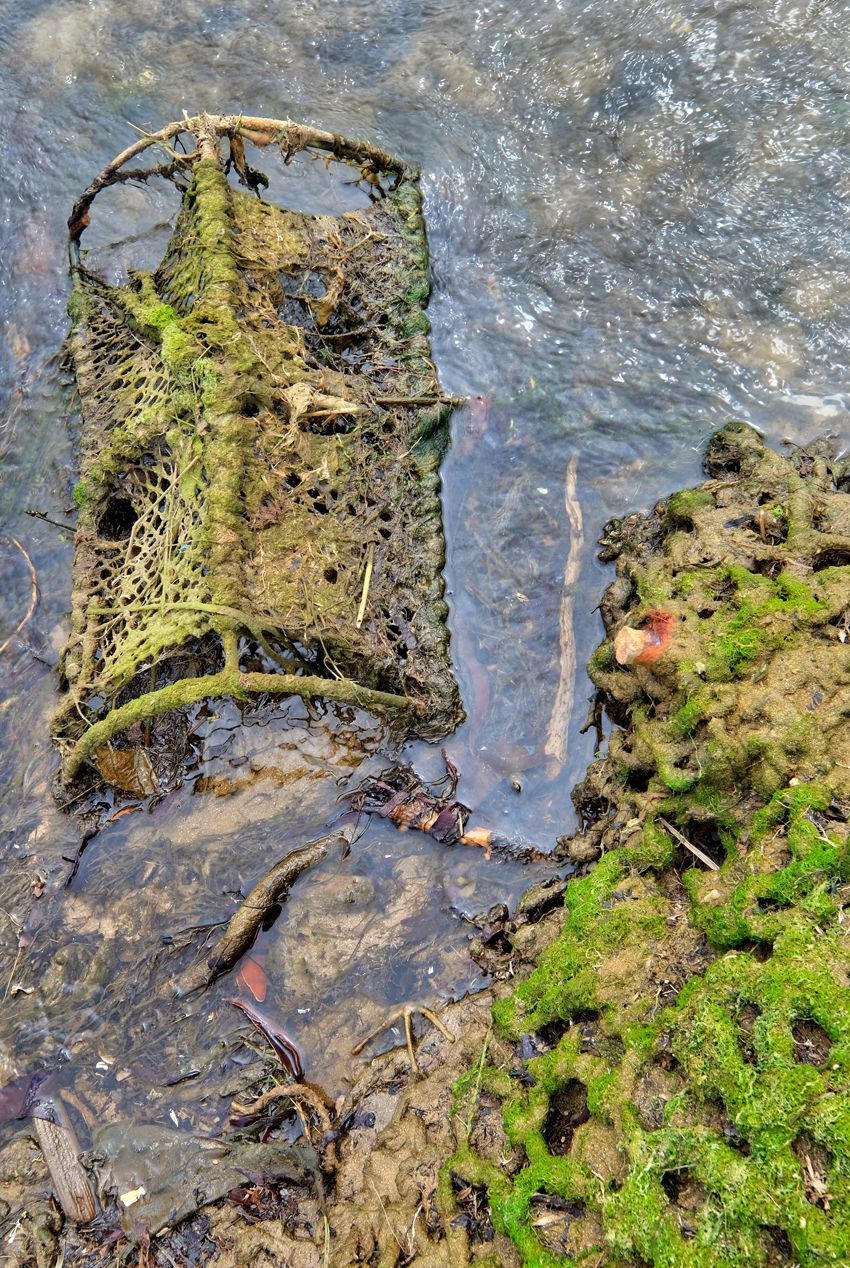 I could not find a way across the burn, The Waters of Philorth, so I followed it inland, stopping here and there to study scenes of beauty.
I could not find a way across the burn, The Waters of Philorth, so I followed it inland, stopping here and there to study scenes of beauty.
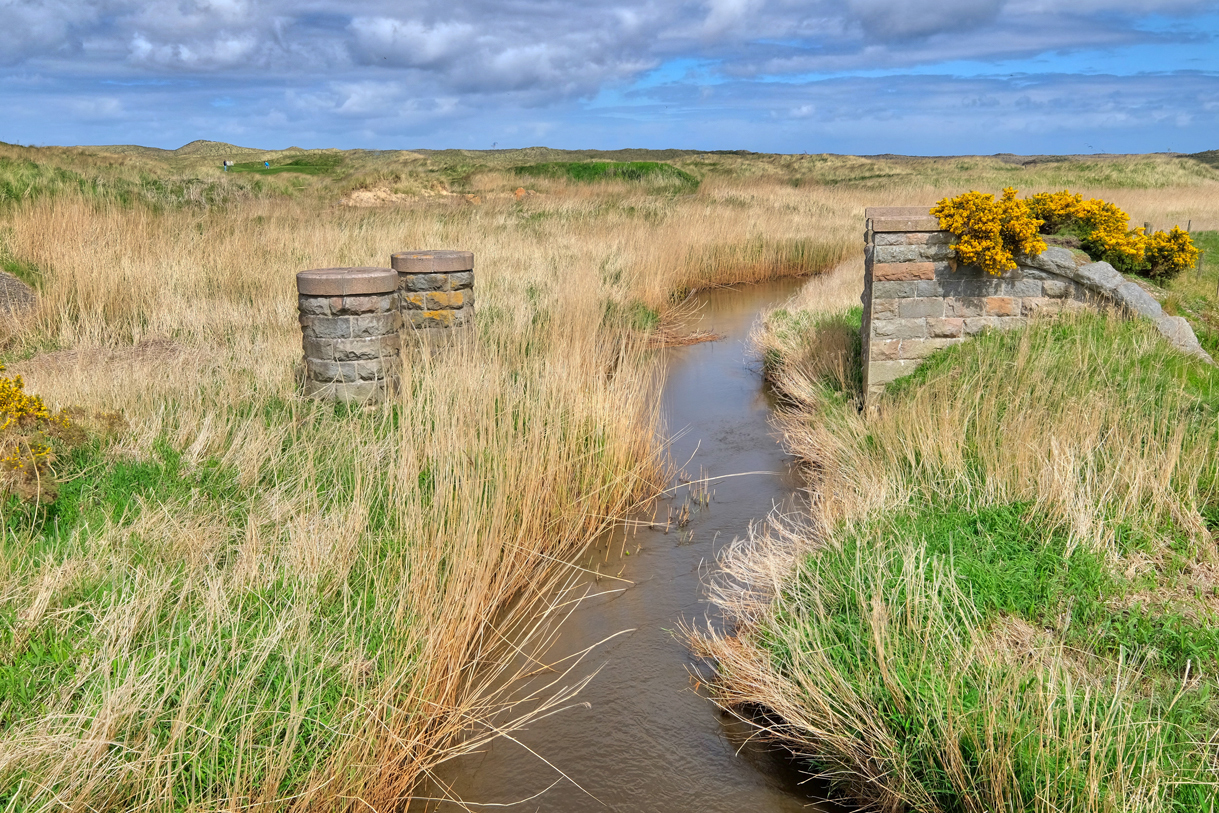 The Waters of Philorth eventually came to the highway and this old disassembled rail bridge.
The Waters of Philorth eventually came to the highway and this old disassembled rail bridge.
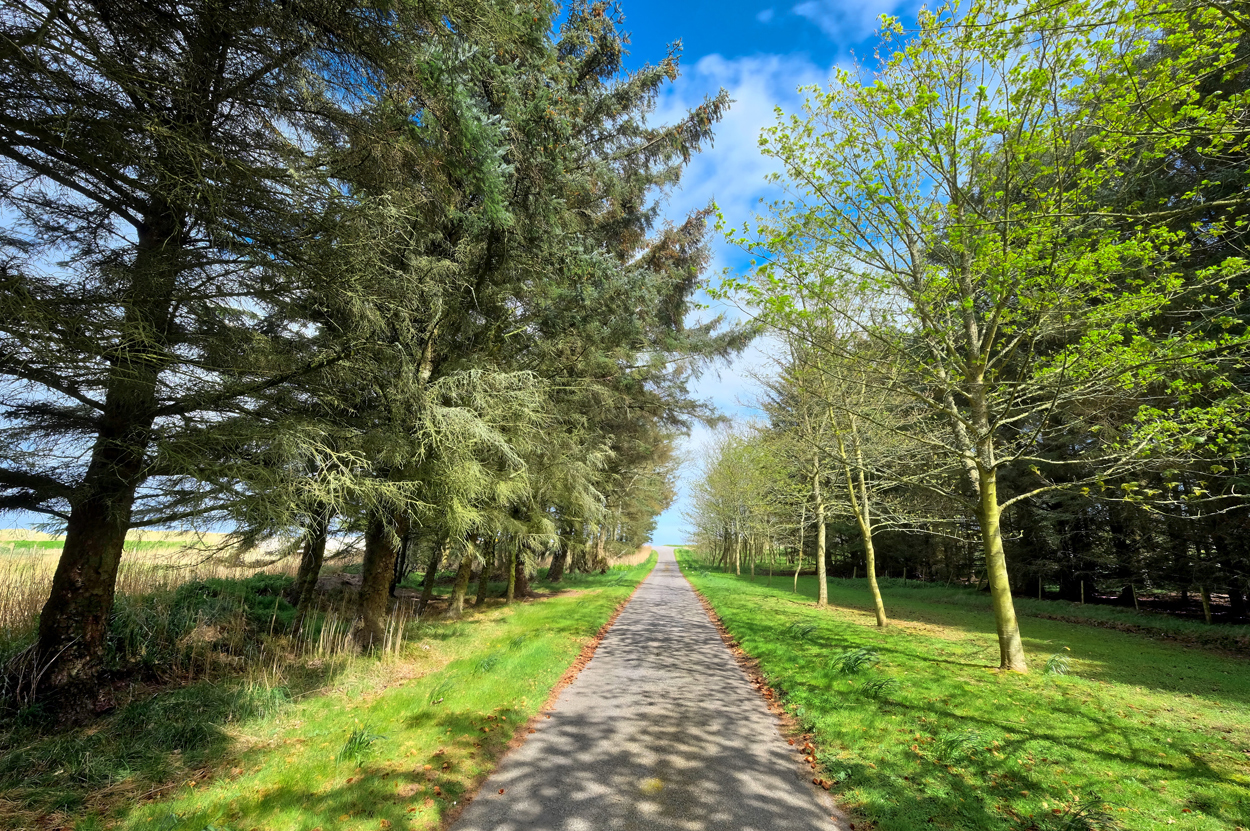 This inviting road stood in front of me, so I walked in until . . .
This inviting road stood in front of me, so I walked in until . . .
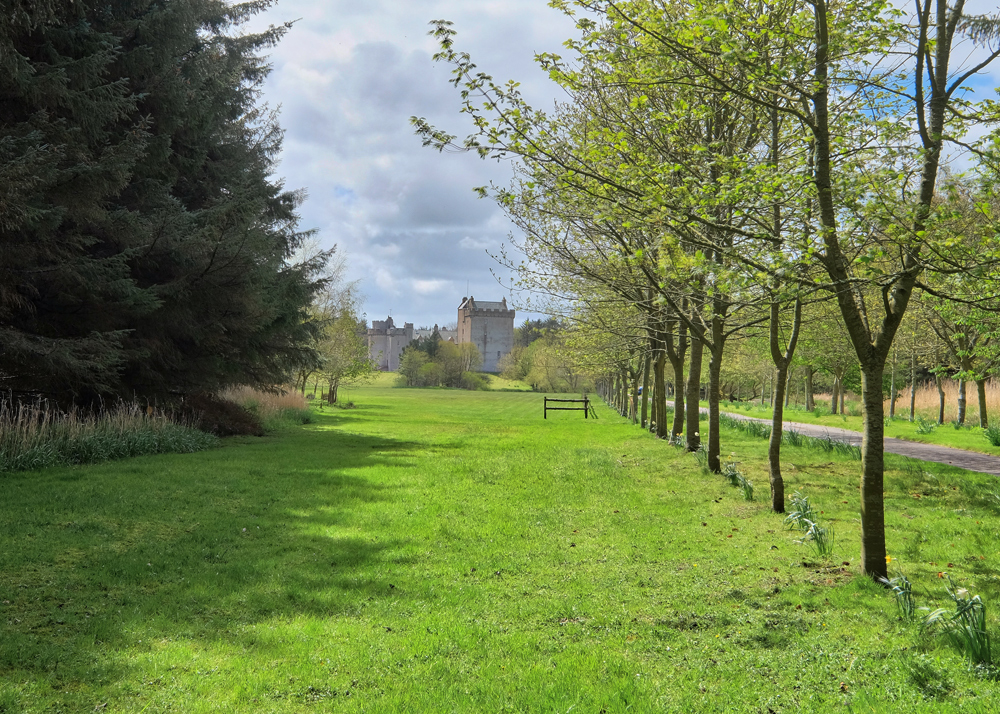 I walked up the road, which turned out to be the driveway of Castle Cairnbulg . . . and a 'Private Property' sign. Yes, this is not only a real castle, but it has been continuously occupied by the original Fraser family since 1308. Currently. Katharine Fraser, Mistress of Salton, resides within the 700 year old walls.
I walked up the road, which turned out to be the driveway of Castle Cairnbulg . . . and a 'Private Property' sign. Yes, this is not only a real castle, but it has been continuously occupied by the original Fraser family since 1308. Currently. Katharine Fraser, Mistress of Salton, resides within the 700 year old walls.
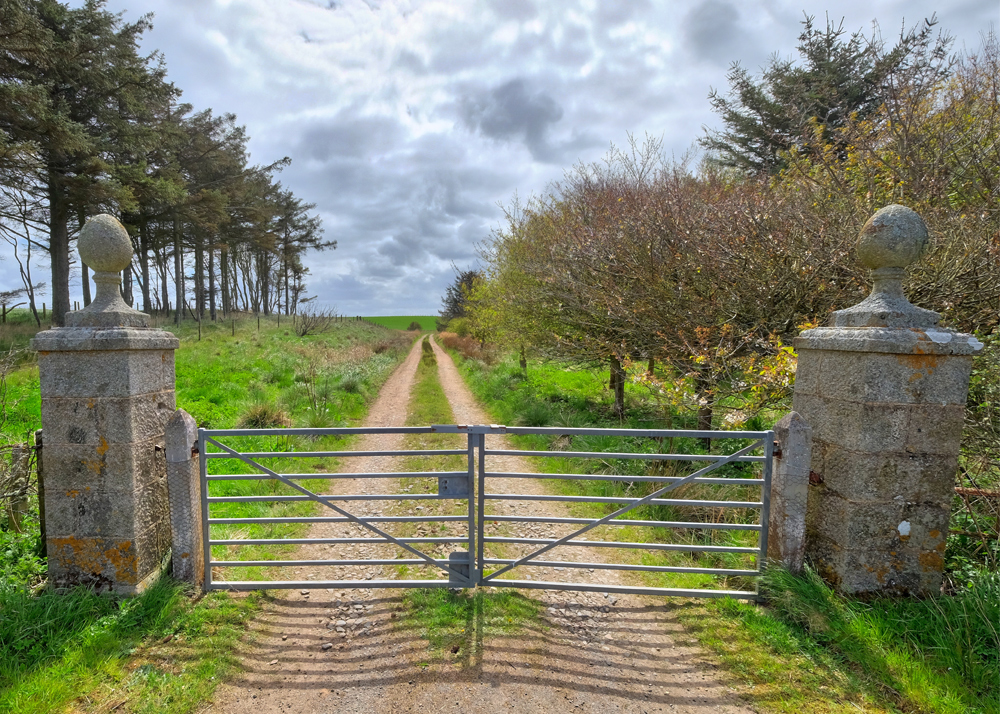 I considered jumping the estate gates and exploring the park-like grounds of the castle . . . but didn't.
I considered jumping the estate gates and exploring the park-like grounds of the castle . . . but didn't.
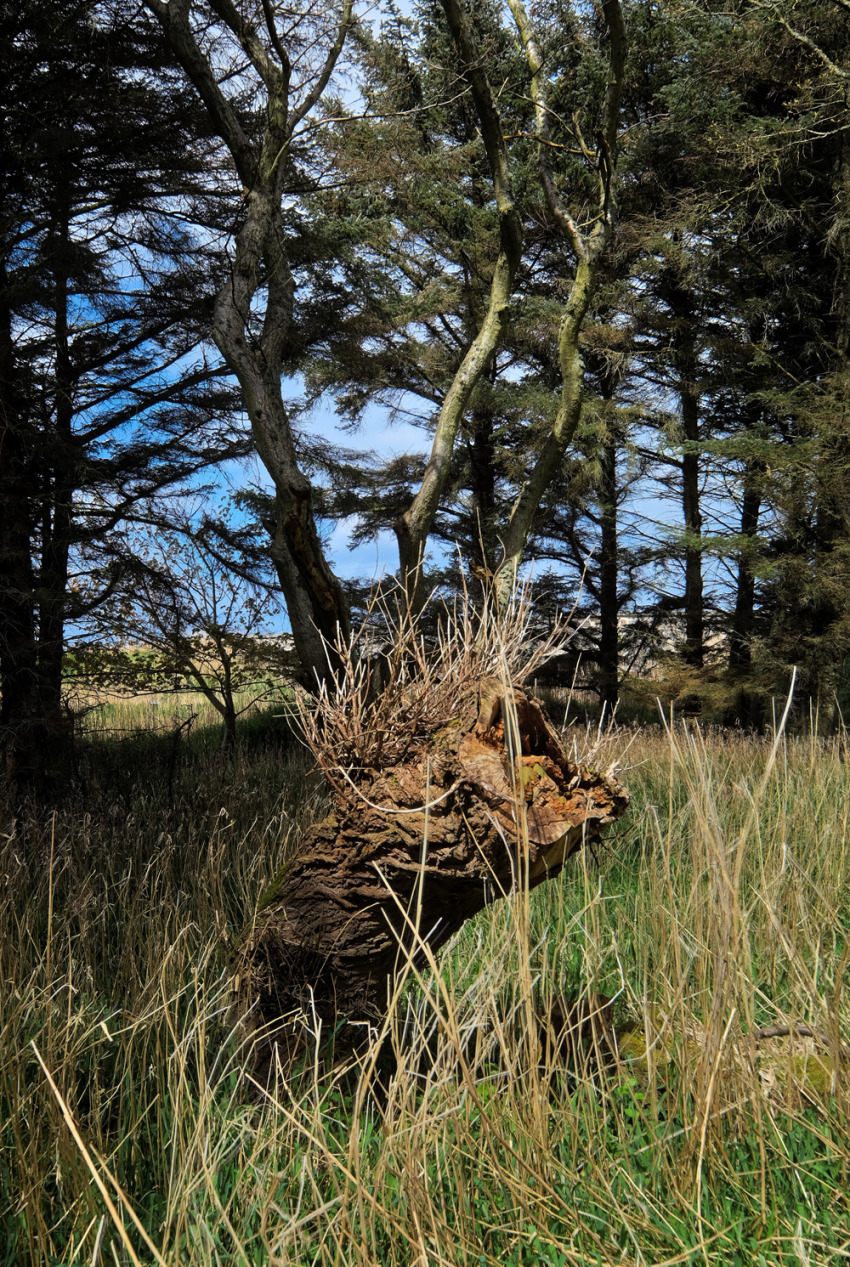 I took a shortcut though a small wood and found this striking stump.
I took a shortcut though a small wood and found this striking stump.
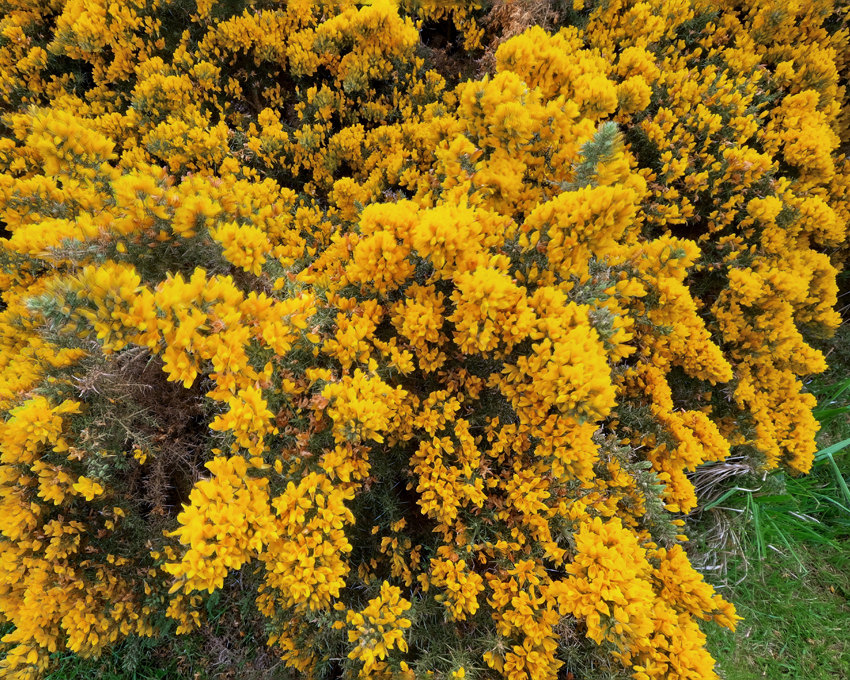 The gorse (ulex europaeus) was in full bloom.
The gorse (ulex europaeus) was in full bloom.
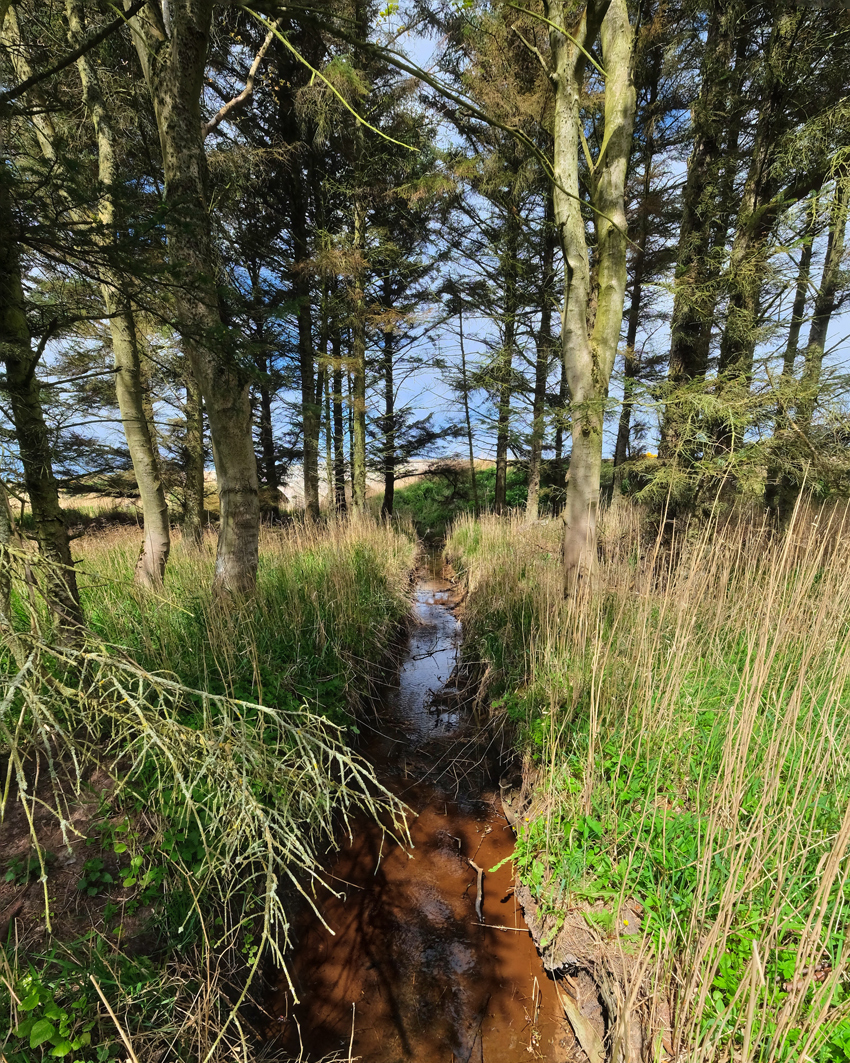 Boggy land draining.
Boggy land draining.
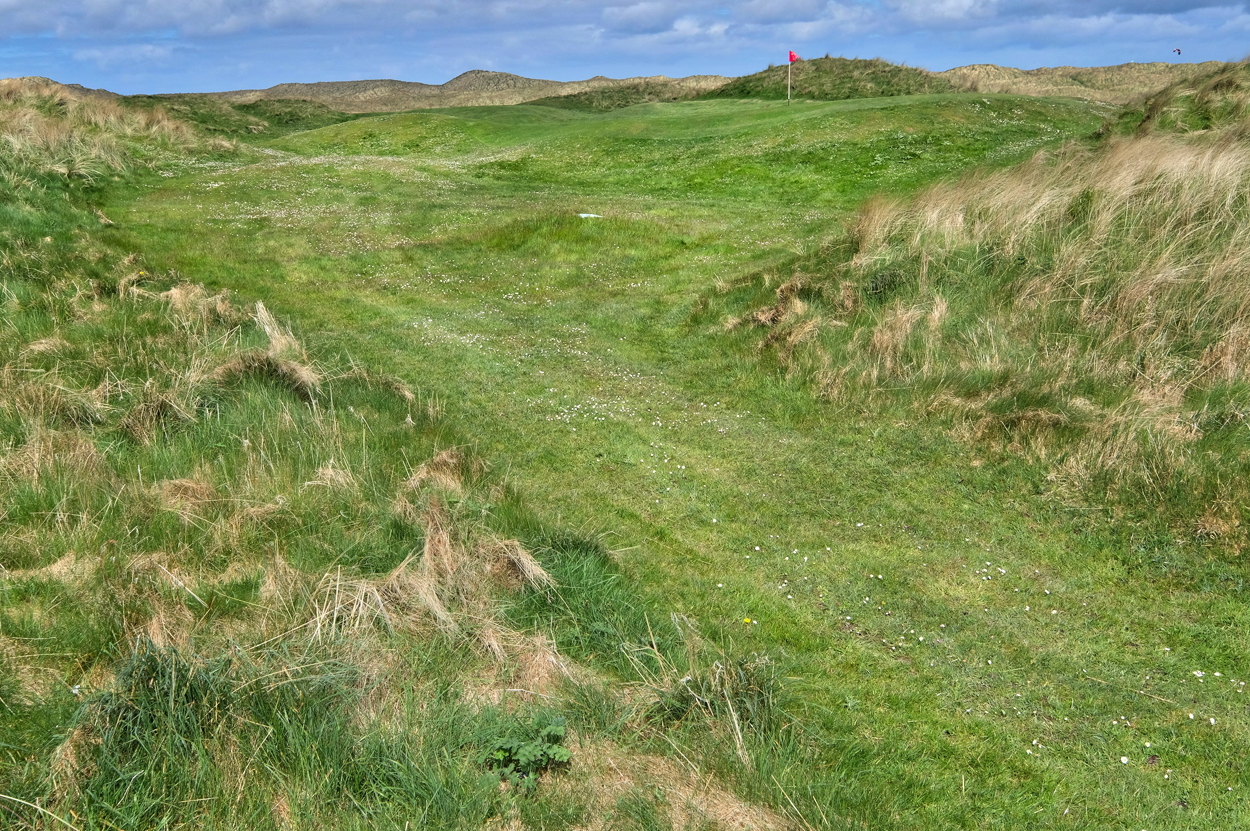 Of course, this trip was about my wife playing in a golf tournament. I walked back through the historic golf course to the Fraserburgh Golf Club, the 7th oldest golf course in the world. Although the golf club was officially established in 1777, golf has been recorded being played here since 1618 . . . 398 years!
Of course, this trip was about my wife playing in a golf tournament. I walked back through the historic golf course to the Fraserburgh Golf Club, the 7th oldest golf course in the world. Although the golf club was officially established in 1777, golf has been recorded being played here since 1618 . . . 398 years!
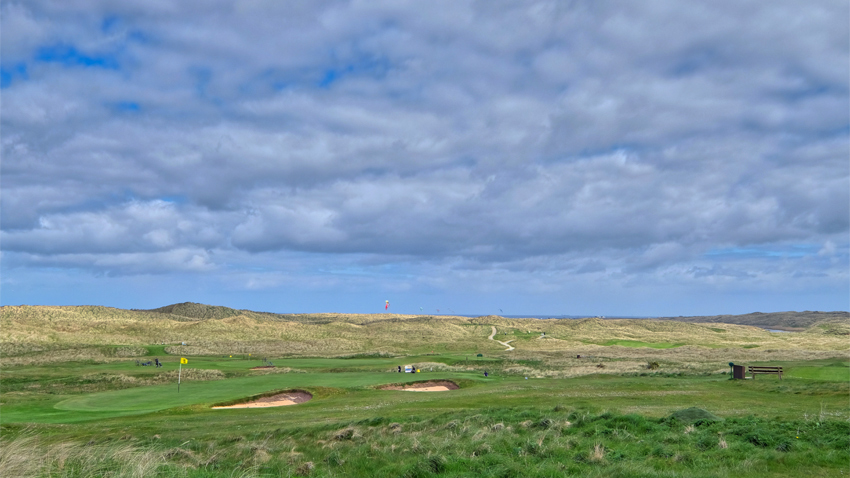 It is a beautiful course in a beautiful setting. It had been a fine day . . . with a five-mile walk.
It is a beautiful course in a beautiful setting. It had been a fine day . . . with a five-mile walk.
Scotland Photos: The Tattie Hols Road Trip 2014
 Saturday, March 19, 2016 at 4:56PM
Saturday, March 19, 2016 at 4:56PM This blog entry is a little late in getting posted . . . my wonderful wife and I took this trip in mid-October 2014 . . . but the busyness of my life has, unfortunately, kept me from post-processing (I do very little) and posting. ENJOY!
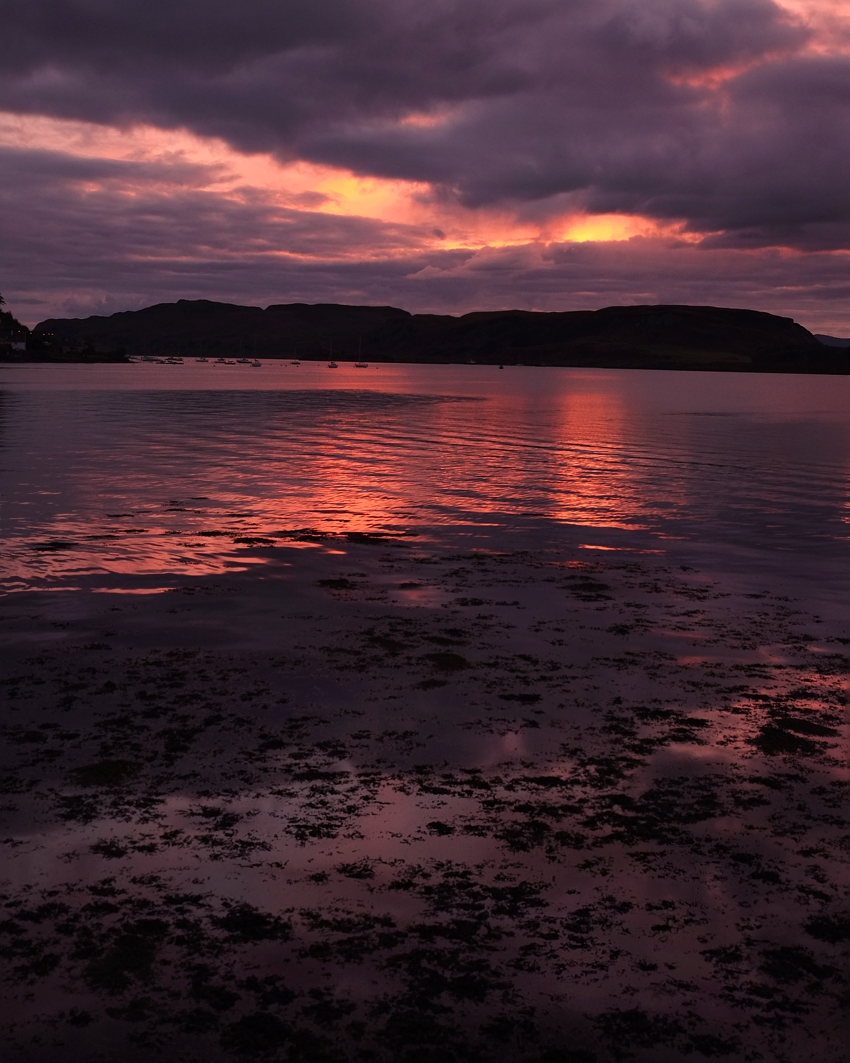 Oban Bay sunset on our Tattie Hols road trip.
Oban Bay sunset on our Tattie Hols road trip.
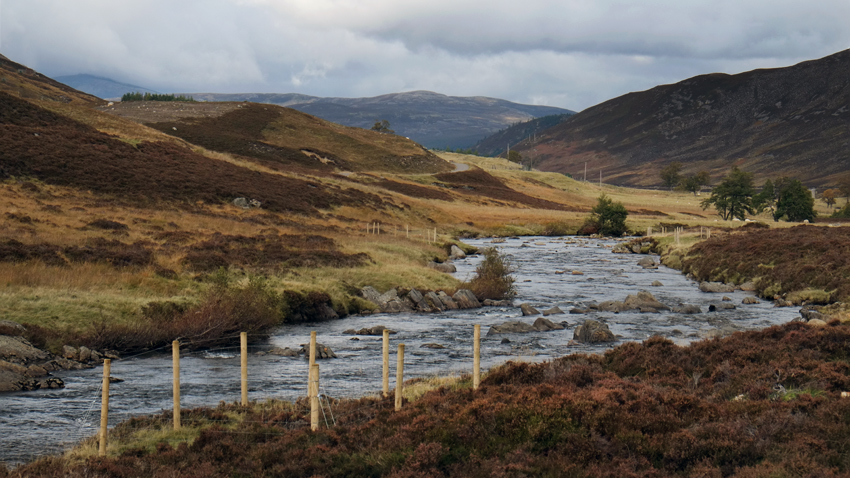 In Scotland the schools have either a one or two week holiday, called The Tattie Hols, so the students can help harvest the potatoes. Not many young people harvest potatoes today, but the holiday remains. I had a one-week holiday and, as we have done the past several years, took a road trip somewhere in Scotland. We headed due west over the Grampian Mountains. This is the upper River Dee.
In Scotland the schools have either a one or two week holiday, called The Tattie Hols, so the students can help harvest the potatoes. Not many young people harvest potatoes today, but the holiday remains. I had a one-week holiday and, as we have done the past several years, took a road trip somewhere in Scotland. We headed due west over the Grampian Mountains. This is the upper River Dee.
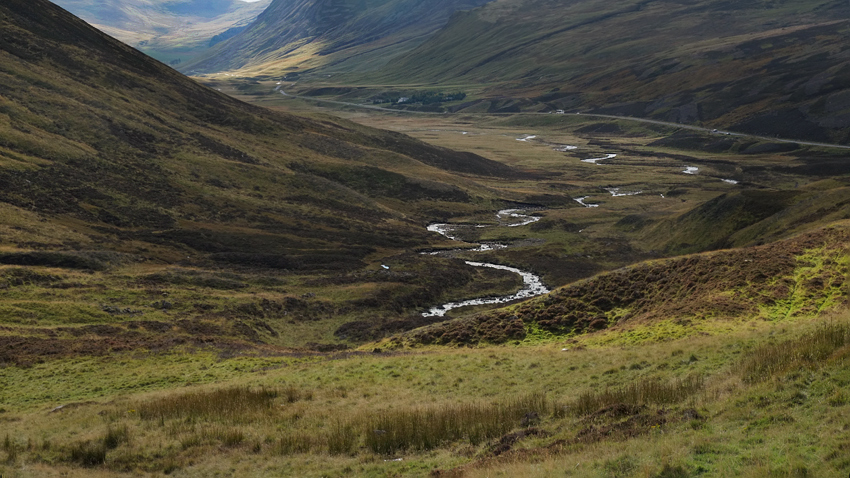 A beautiful glacier-cut valley in the Scottish Highlands.
A beautiful glacier-cut valley in the Scottish Highlands.
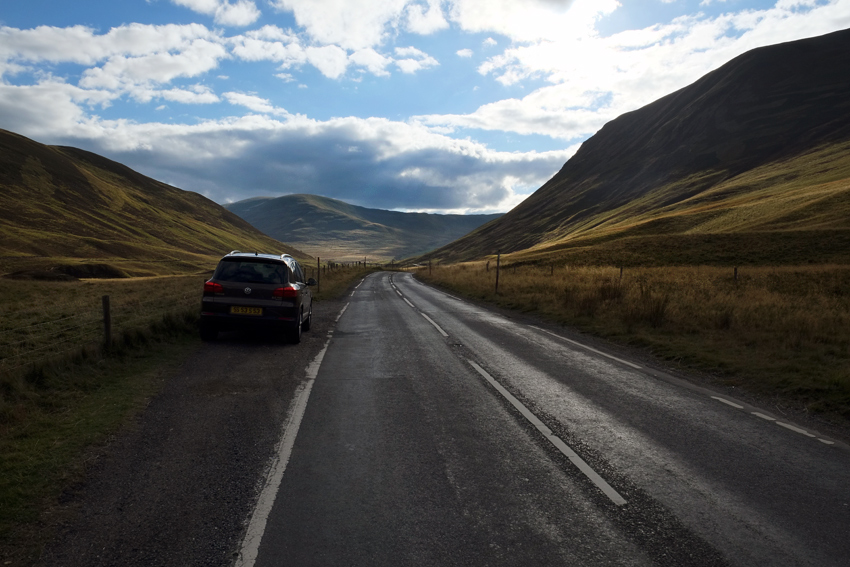 We love our Scottish Highlands road trips.
We love our Scottish Highlands road trips.
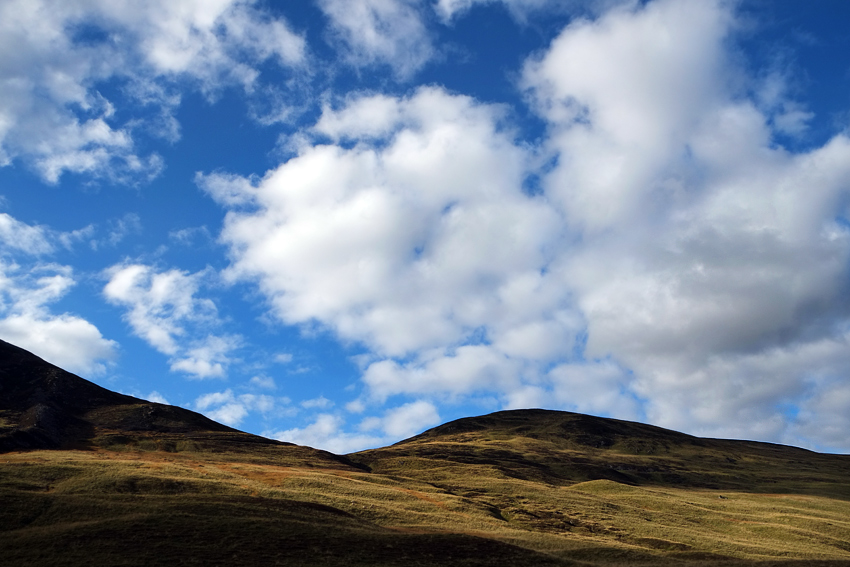 Autumn is our favorite time of the year to be in the Highlands . . . the sky is so magnificent.
Autumn is our favorite time of the year to be in the Highlands . . . the sky is so magnificent.
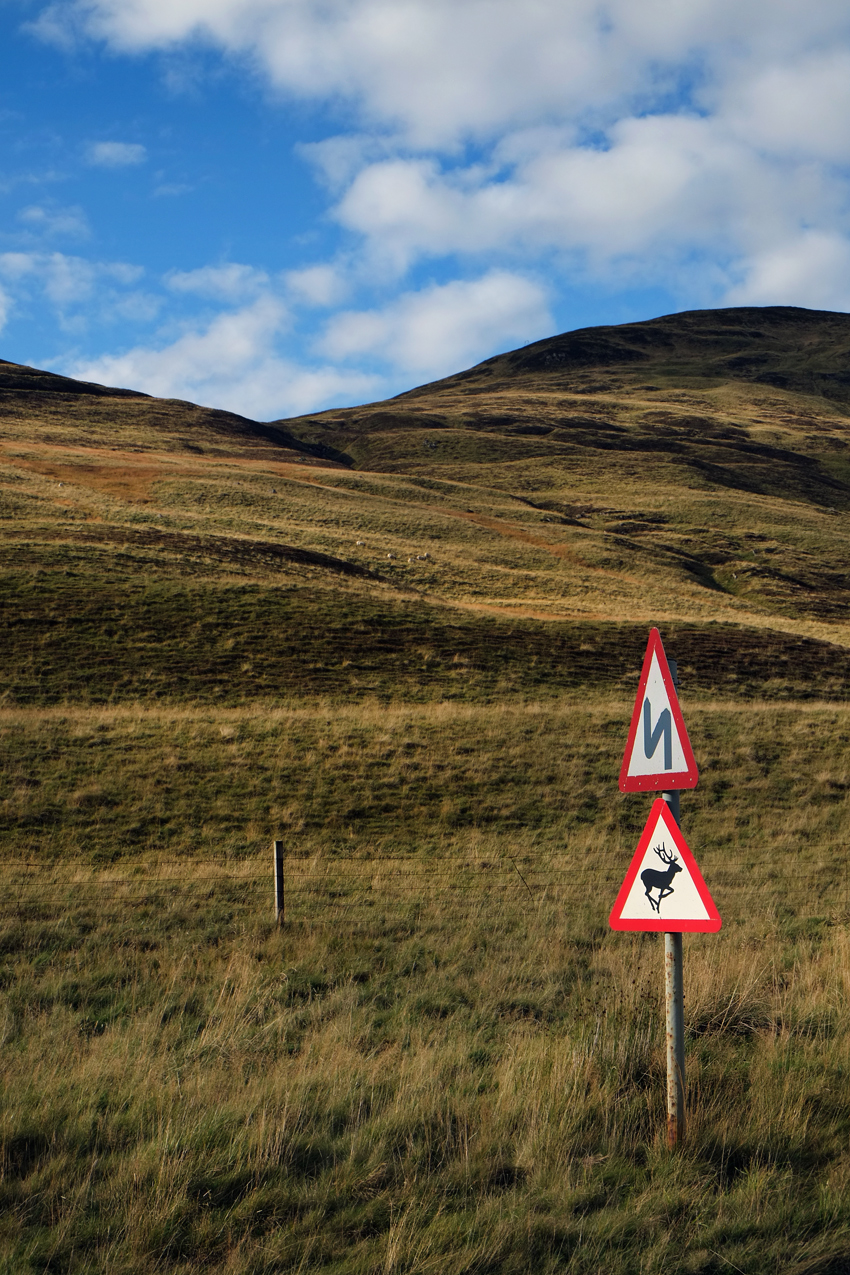 Highlands Fall colour.
Highlands Fall colour.
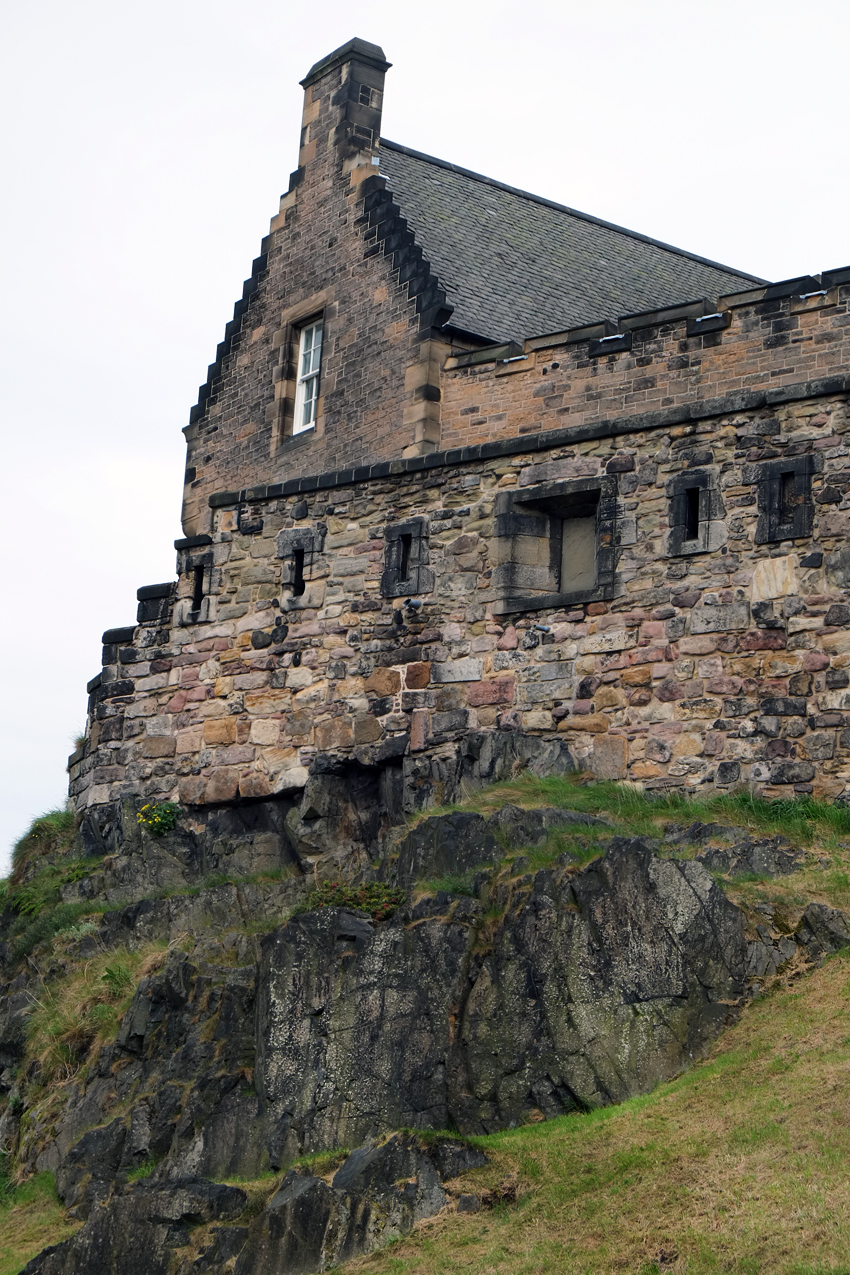 Although there are very few houses in the Highlands, the ones that you do see are stately.
Although there are very few houses in the Highlands, the ones that you do see are stately.
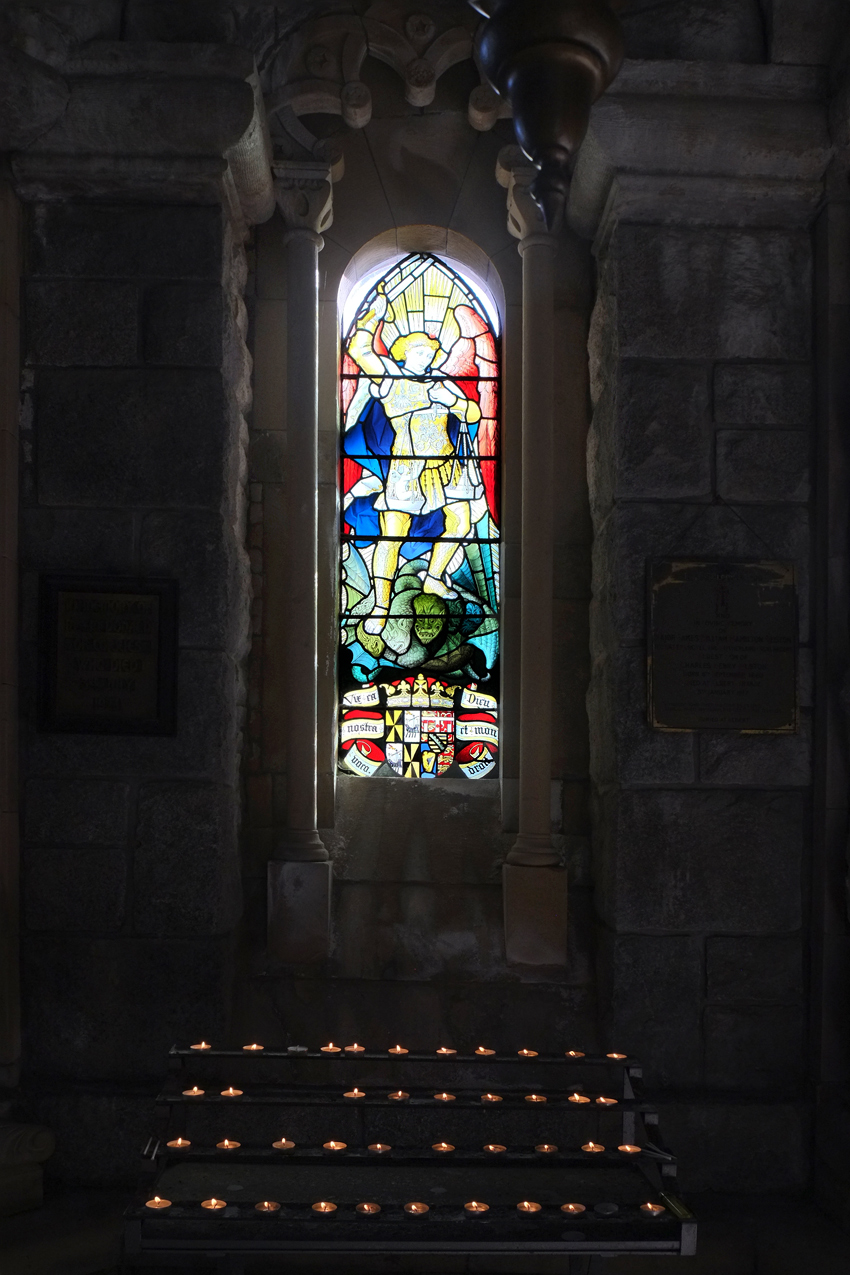 Our route skirted the Grampian Highlands along Loch Awe where we discovered the amazing St. Conan's Kirke.
Our route skirted the Grampian Highlands along Loch Awe where we discovered the amazing St. Conan's Kirke.
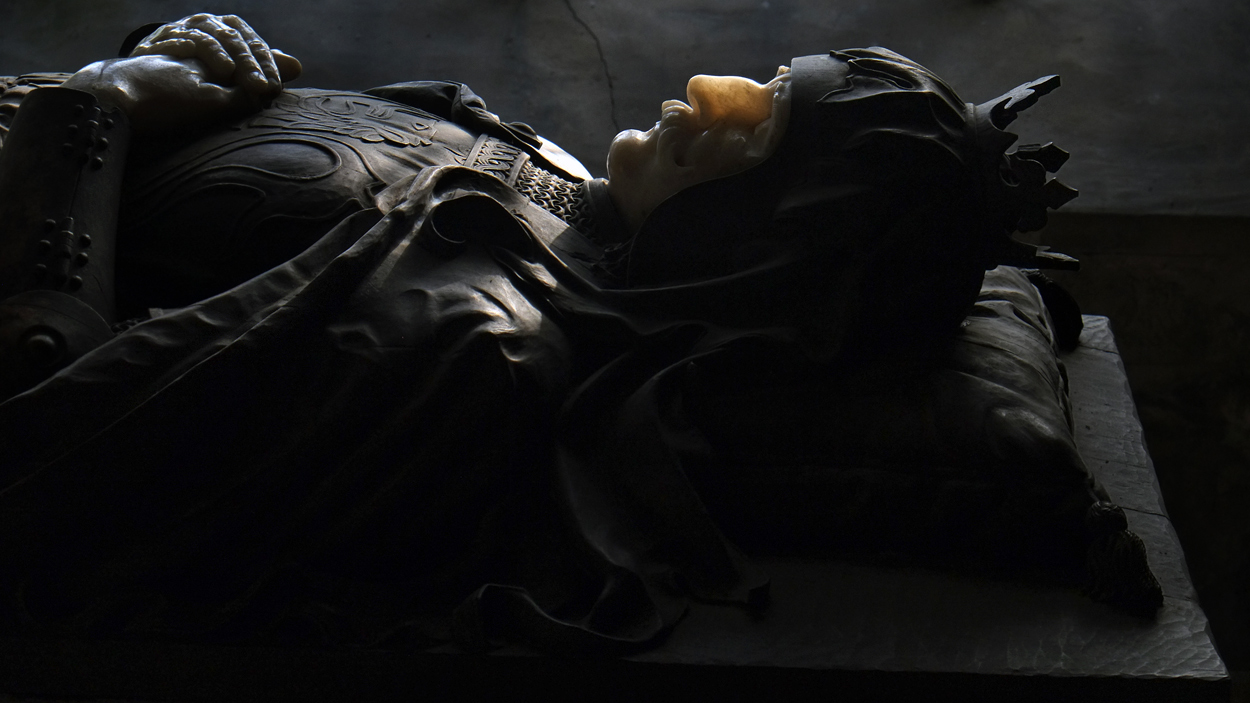 It is rumored that a bone fragment of Robert the Bruce, King of Scotland 1306-1329, is buried here . . . but the LIGHT!
It is rumored that a bone fragment of Robert the Bruce, King of Scotland 1306-1329, is buried here . . . but the LIGHT!
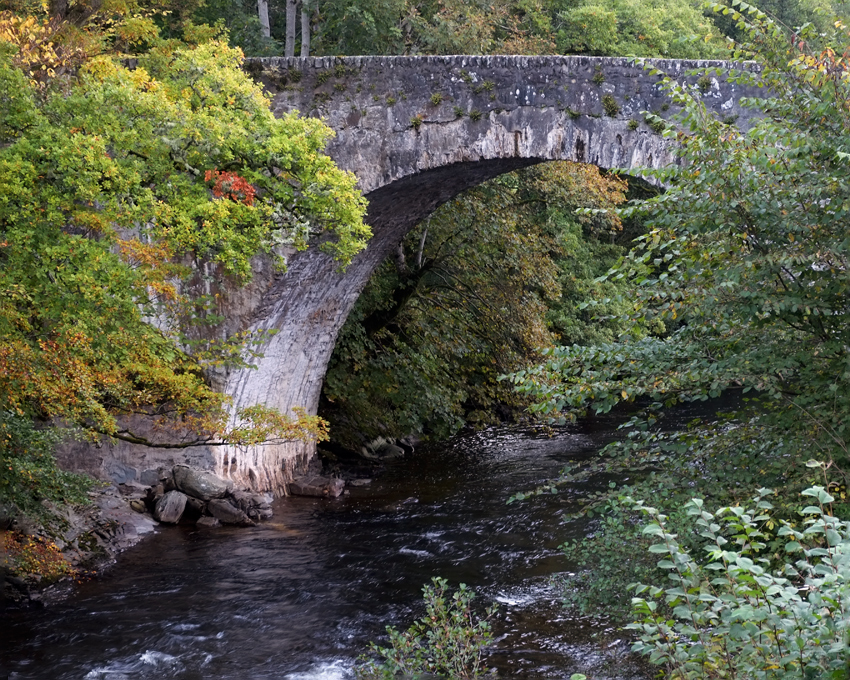 So much to see. After a couple of days through the Highlands, we arrived at the Bridge of Lochay, near Killin.
So much to see. After a couple of days through the Highlands, we arrived at the Bridge of Lochay, near Killin.
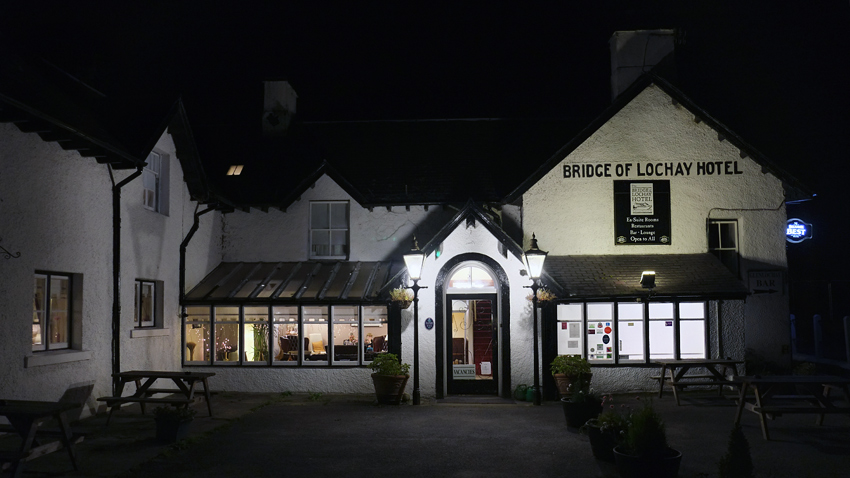 We stayed the night in the old world Bridge of Lochay Hotel.
We stayed the night in the old world Bridge of Lochay Hotel.
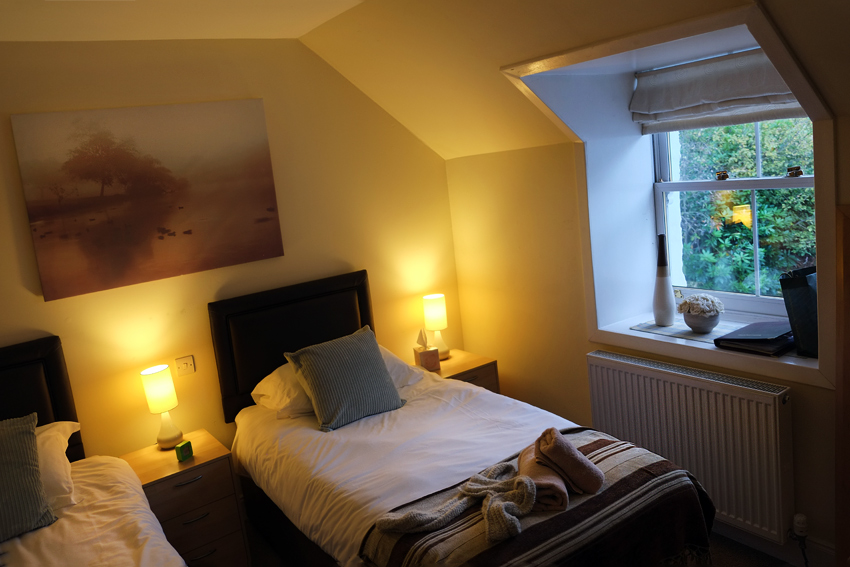 The interior of the Bridge of Lochay Hotel had recently been tastefully renovated.
The interior of the Bridge of Lochay Hotel had recently been tastefully renovated.
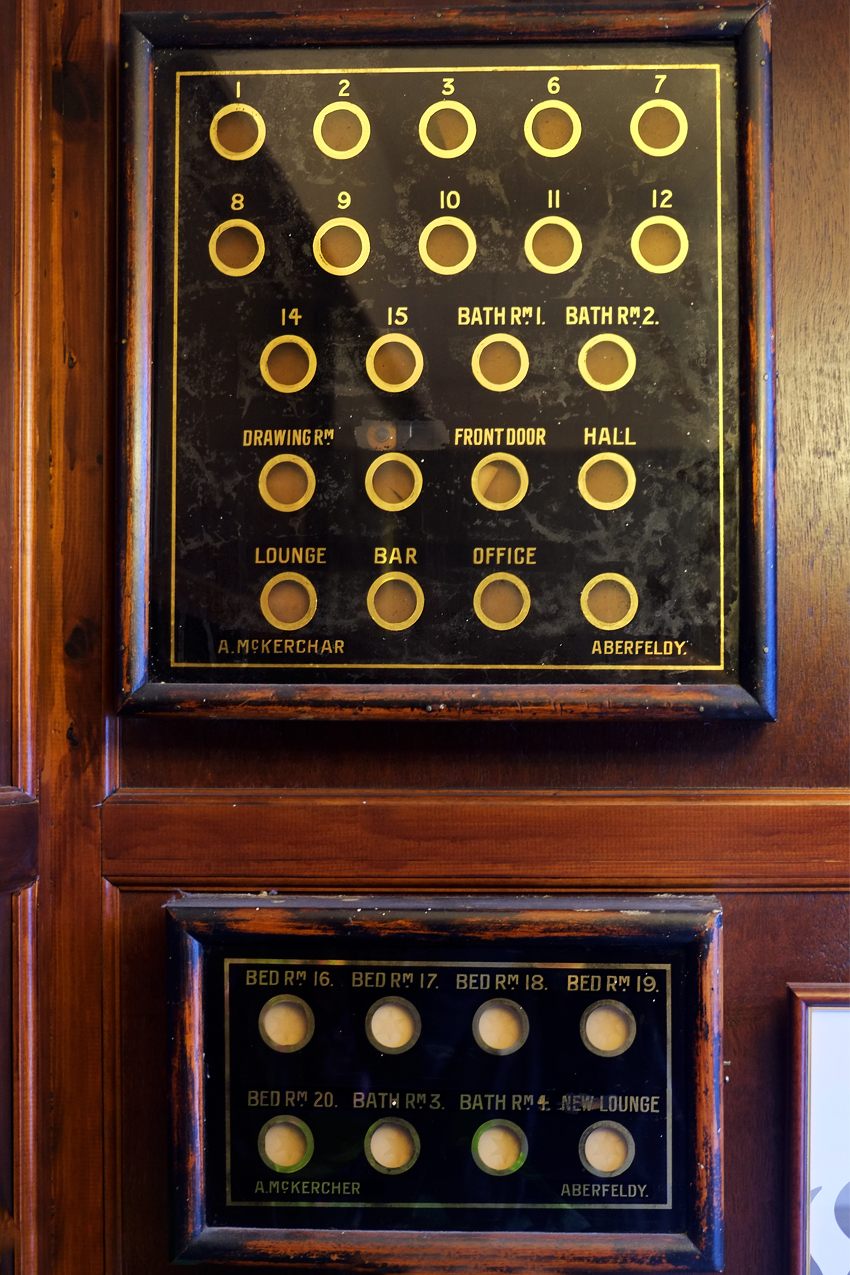 The Bridge of Lochay Hotel had a wonderful old intercom system that must have come when rural electrification arrived.
The Bridge of Lochay Hotel had a wonderful old intercom system that must have come when rural electrification arrived.
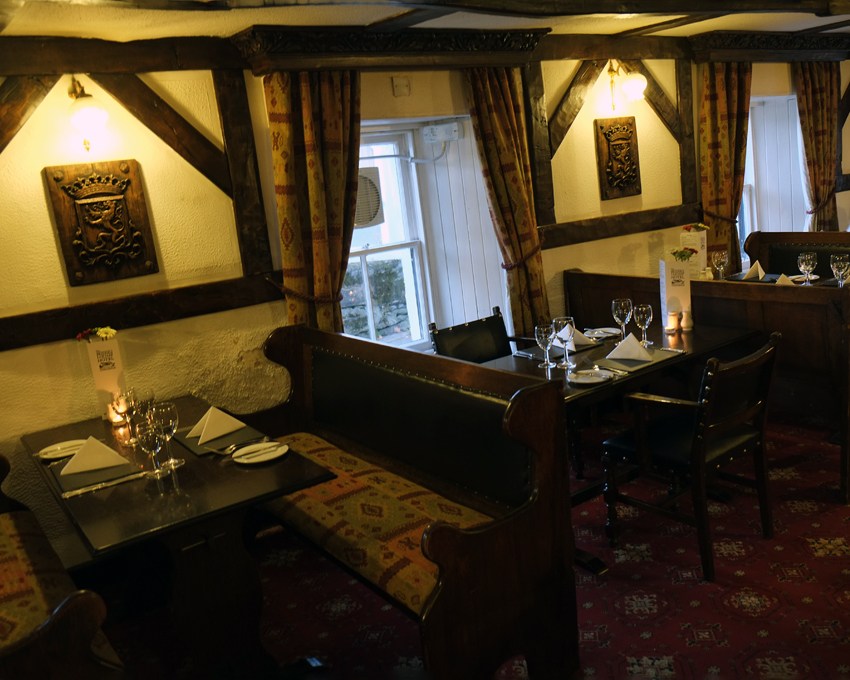 The hotel dining room was quaint . . .
The hotel dining room was quaint . . .
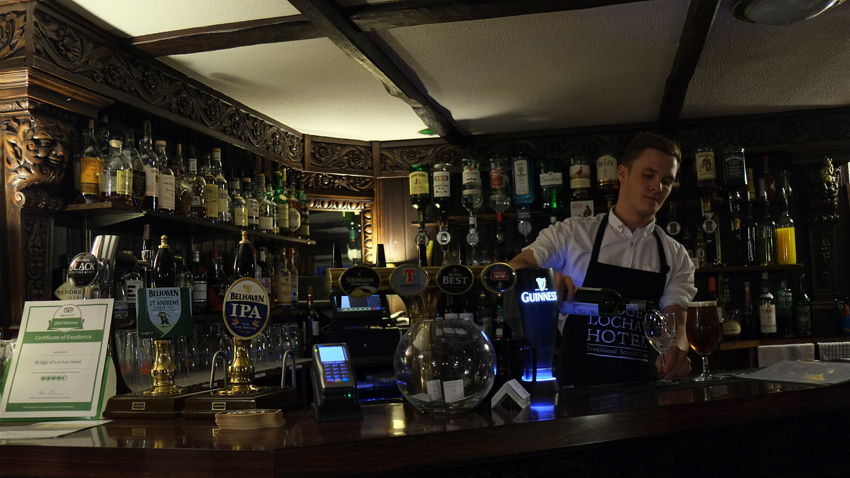 . . . and the barman friendly and skilled.
. . . and the barman friendly and skilled.
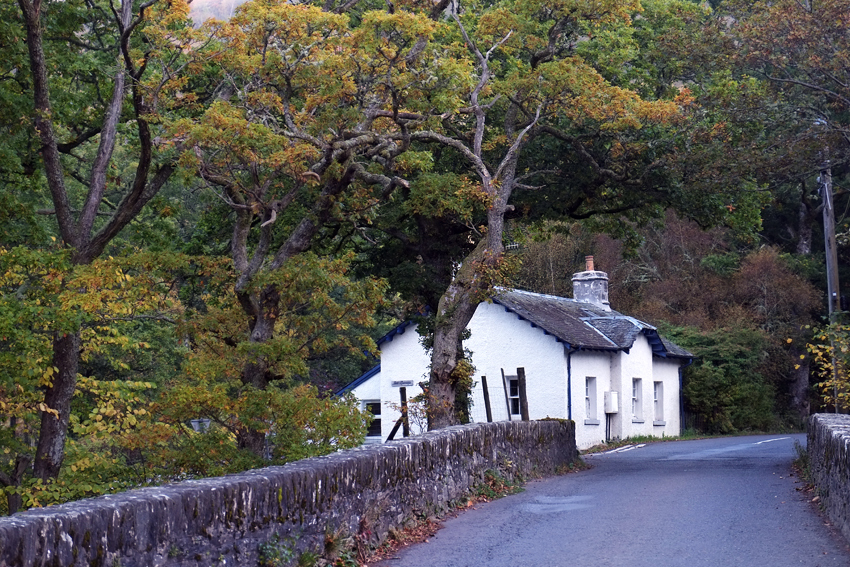 I took an early morning walk across the bridge next to the hotel.
I took an early morning walk across the bridge next to the hotel.
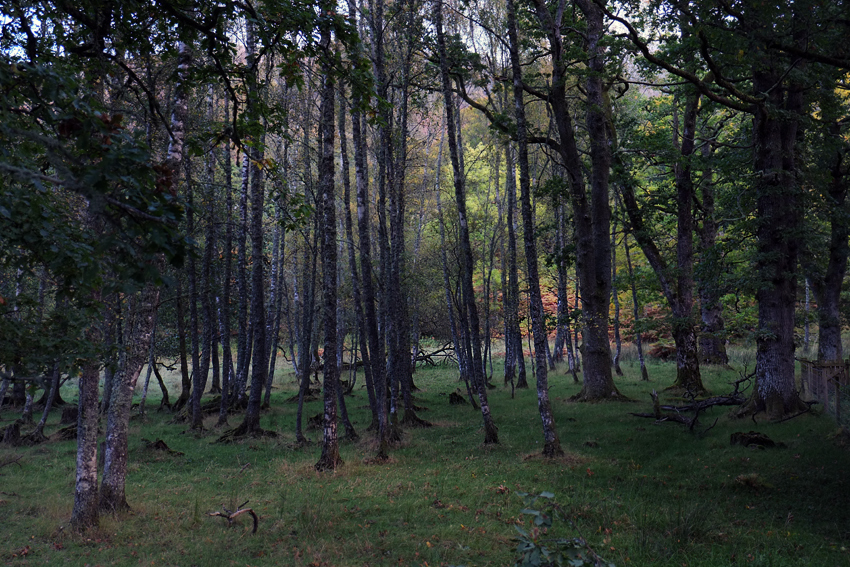 A thin light filtered through the trees.
A thin light filtered through the trees.
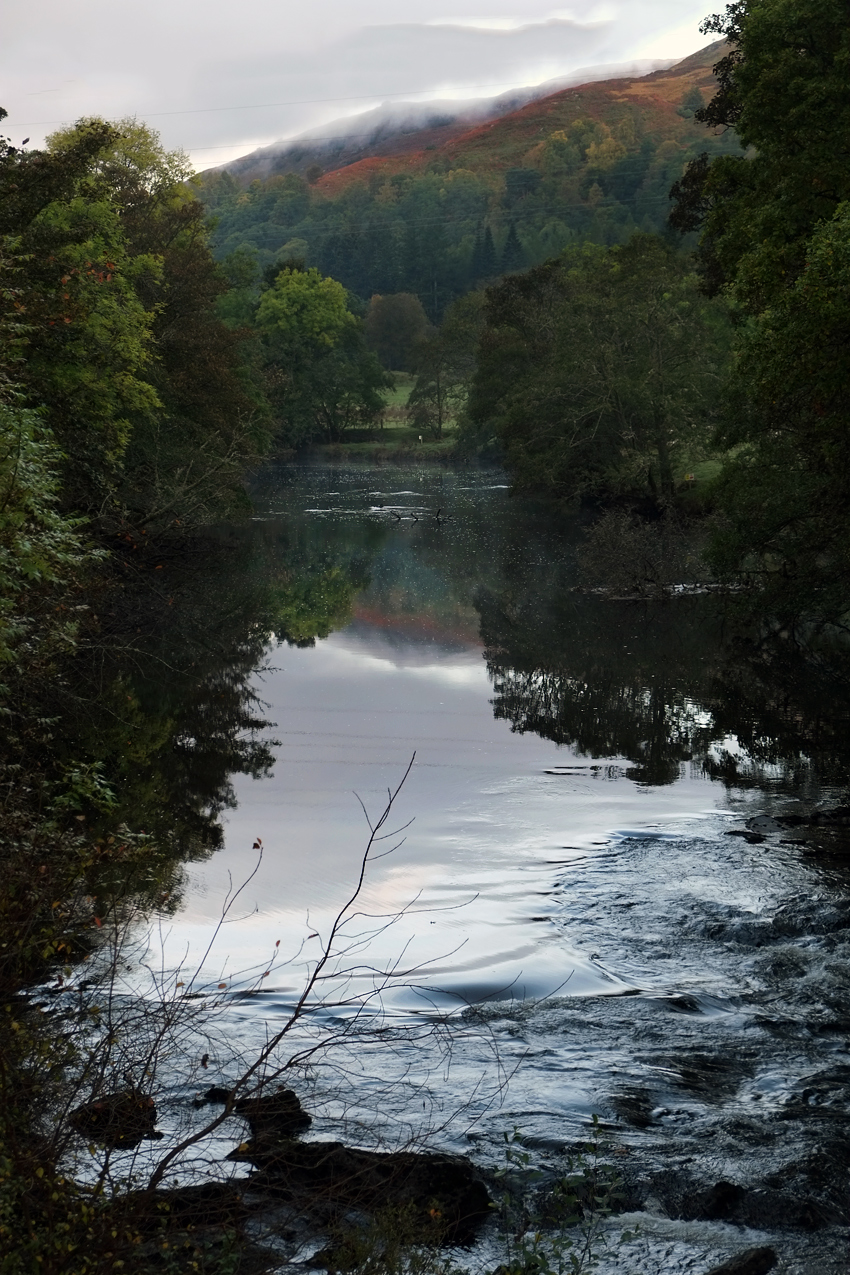 Early morning along the River Lochay.
Early morning along the River Lochay.
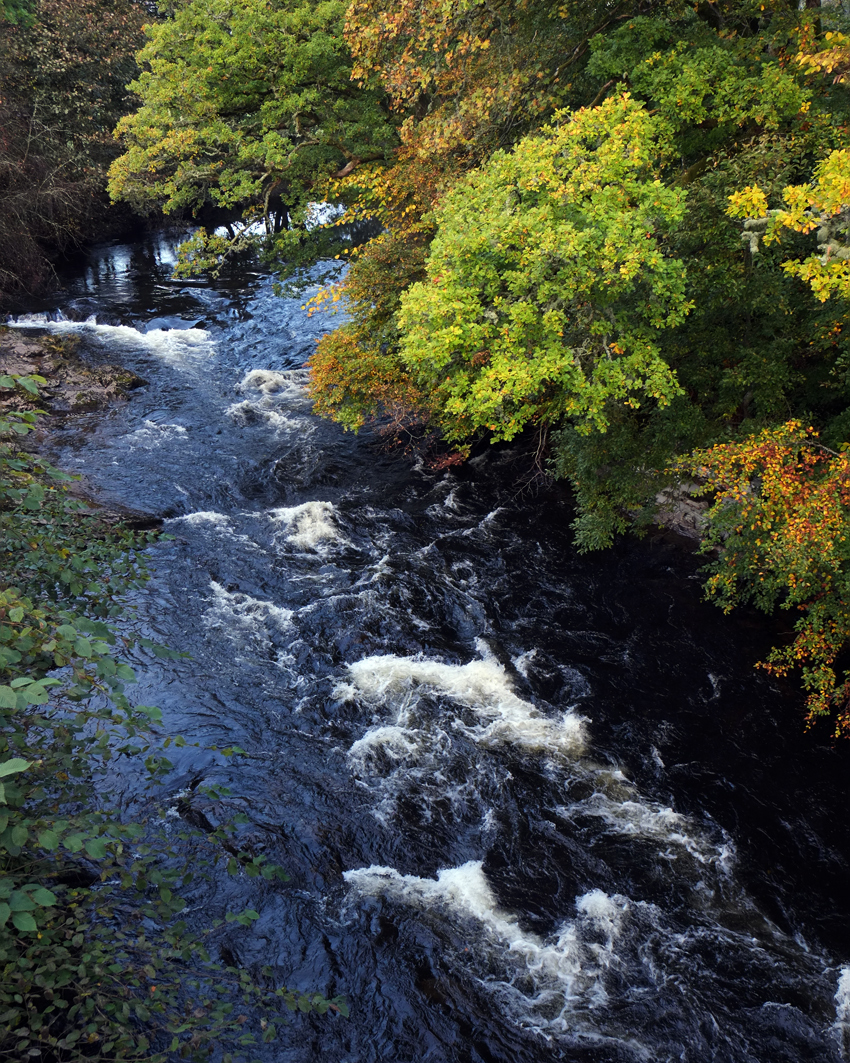 The River Lochay quickened as it fell under the bridge toward Loch Tay.
The River Lochay quickened as it fell under the bridge toward Loch Tay.
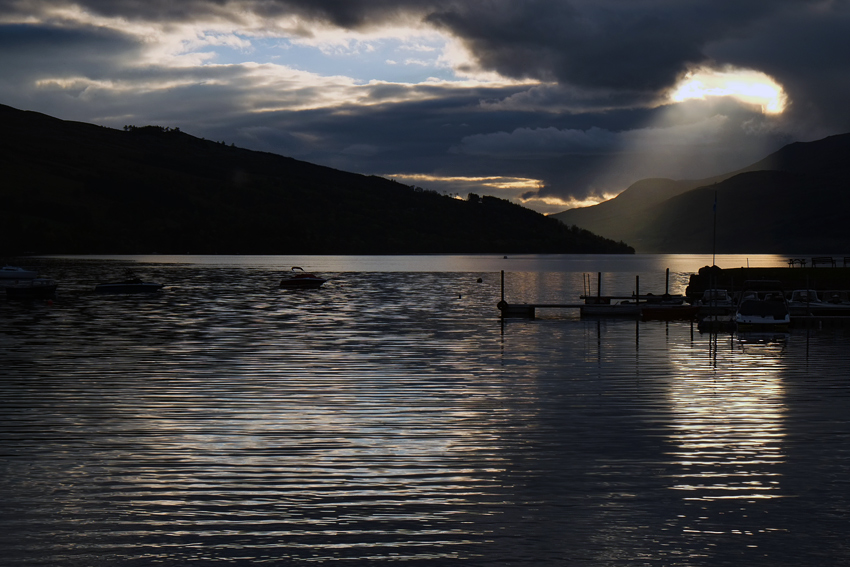 As we rounded a bend in the road coming into Kenmore at the foot of Loch Tay we were stunned with this otherworldly sunset.
As we rounded a bend in the road coming into Kenmore at the foot of Loch Tay we were stunned with this otherworldly sunset.
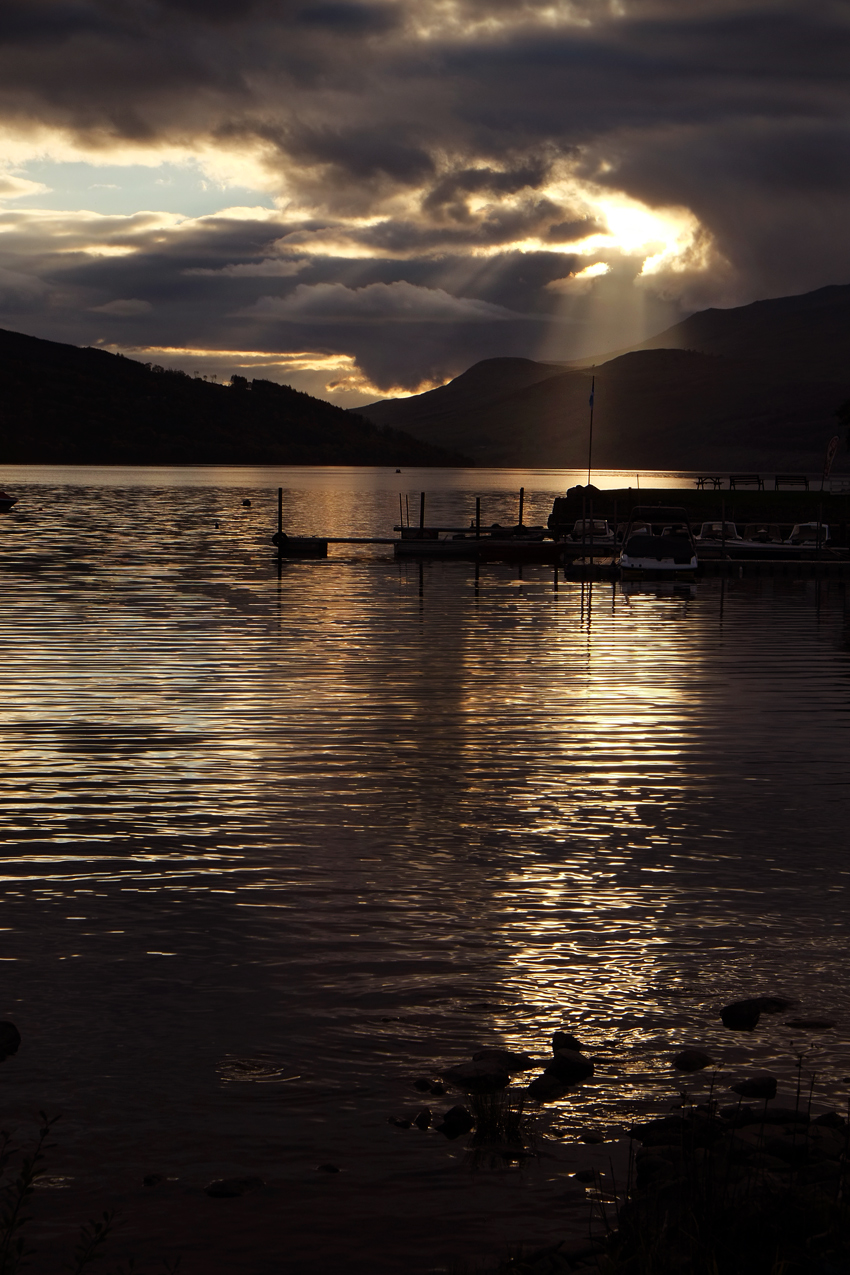 We stayed long enough with our mouths agape in wonder for the sunset to become golden.
We stayed long enough with our mouths agape in wonder for the sunset to become golden.
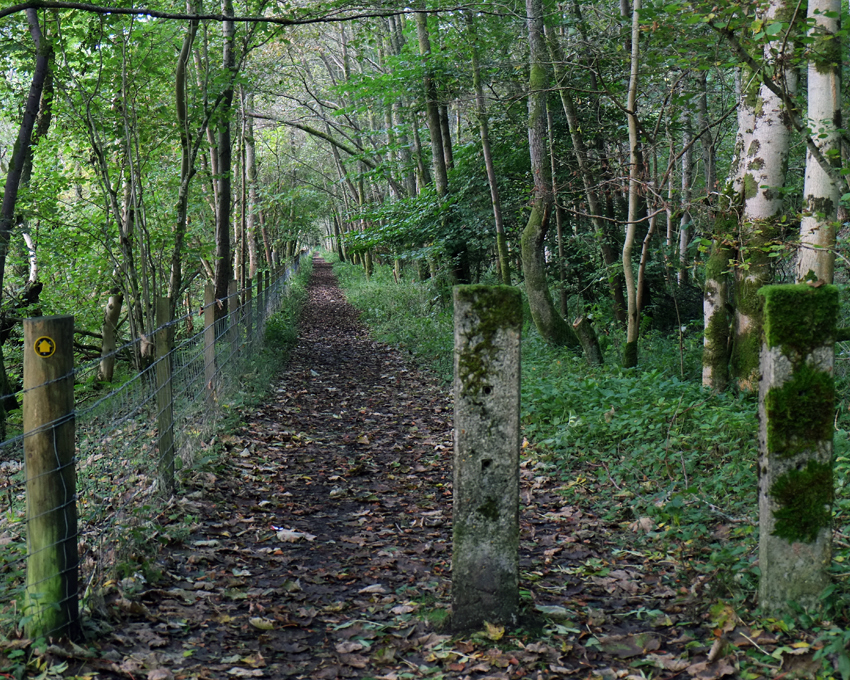 On another morning near Loch Awe, we set off on a wooded trail. There are many, many well-marked trails all over Scotland.
On another morning near Loch Awe, we set off on a wooded trail. There are many, many well-marked trails all over Scotland.
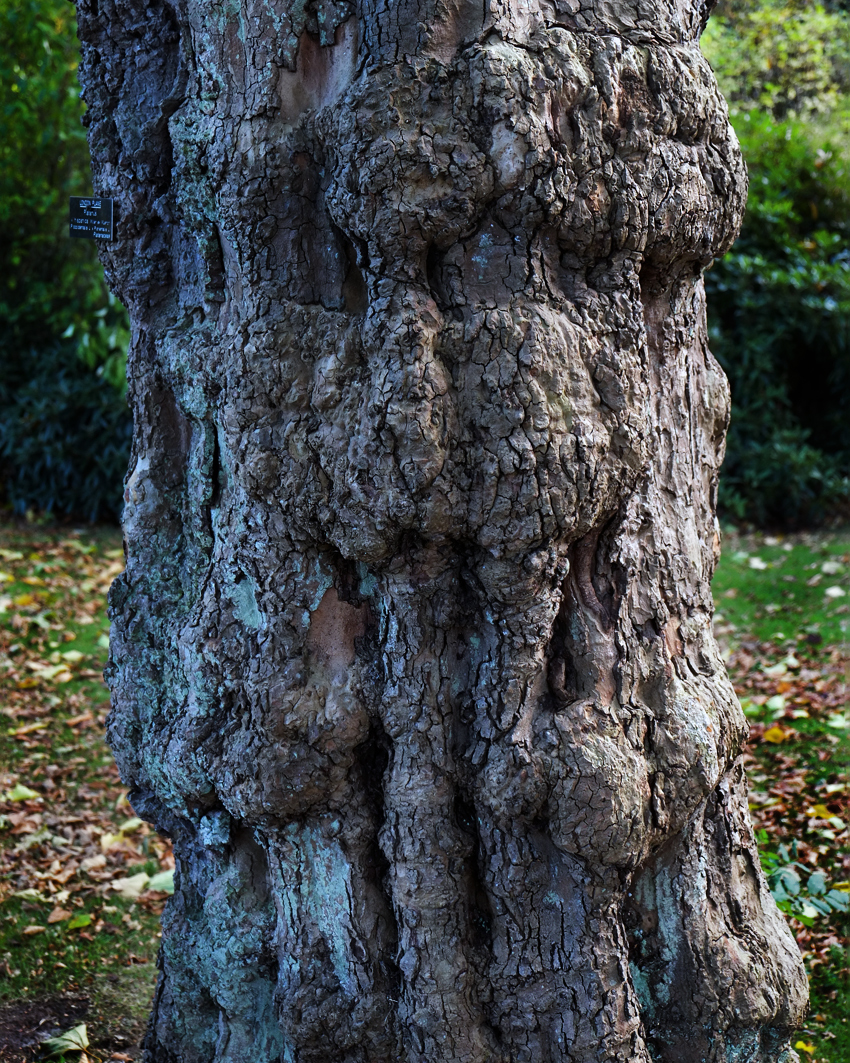 Tree. Forest walk.
Tree. Forest walk.
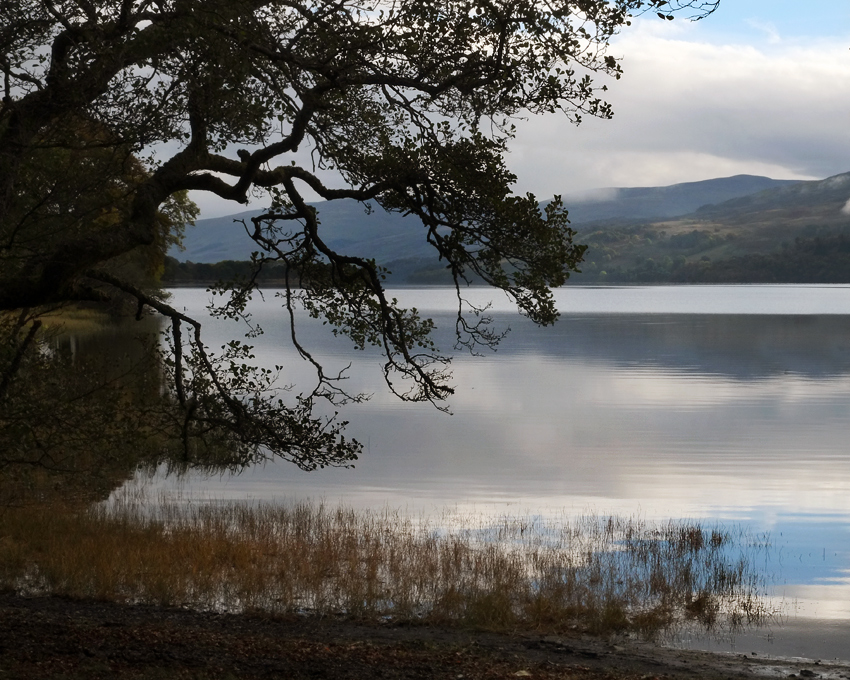 Our trail brought us along the shore of the loch.
Our trail brought us along the shore of the loch.
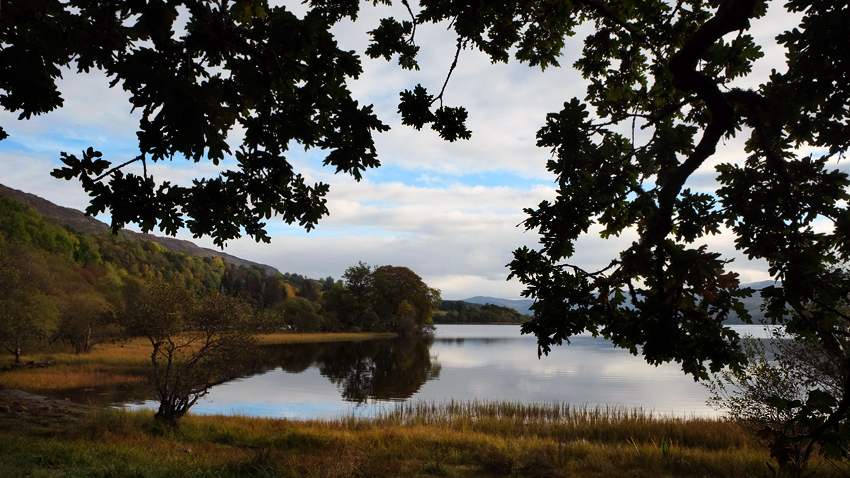 Such beautiful scenery in Scotland.
Such beautiful scenery in Scotland.
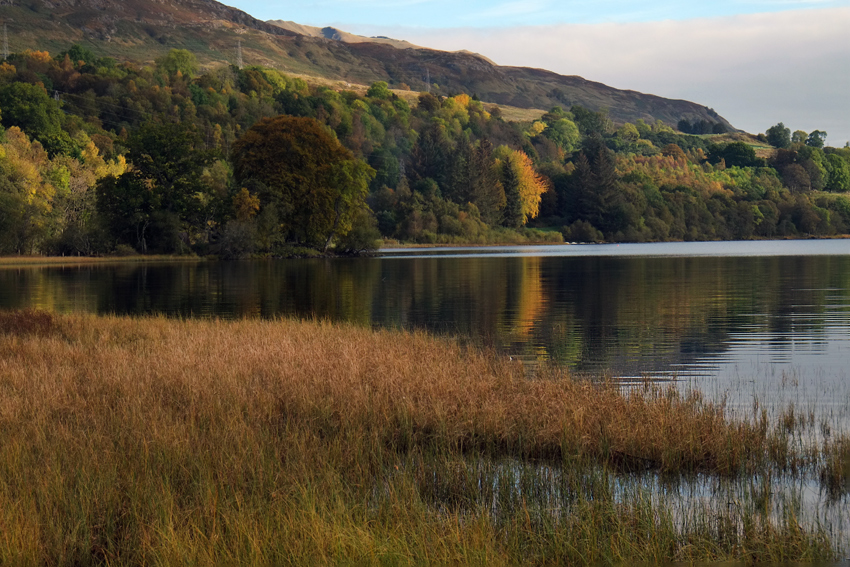 Scenery to inspire a landscape artist.
Scenery to inspire a landscape artist.
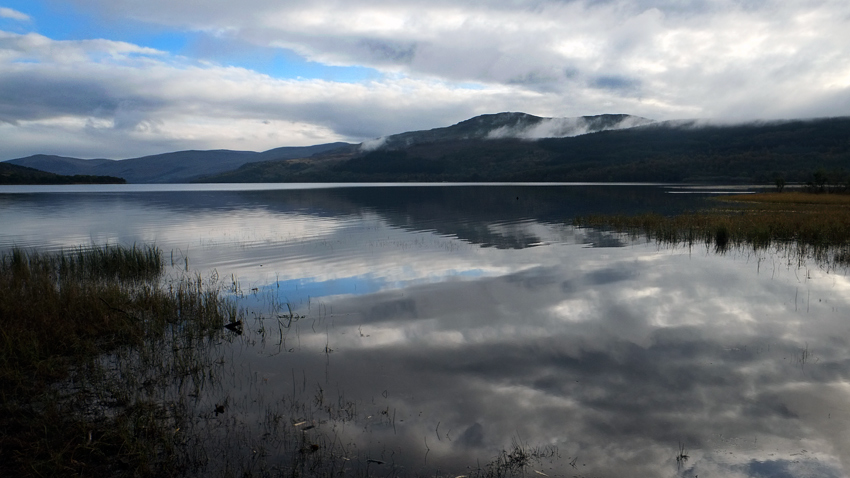 The sky and light ever-changing . . . .
The sky and light ever-changing . . . .
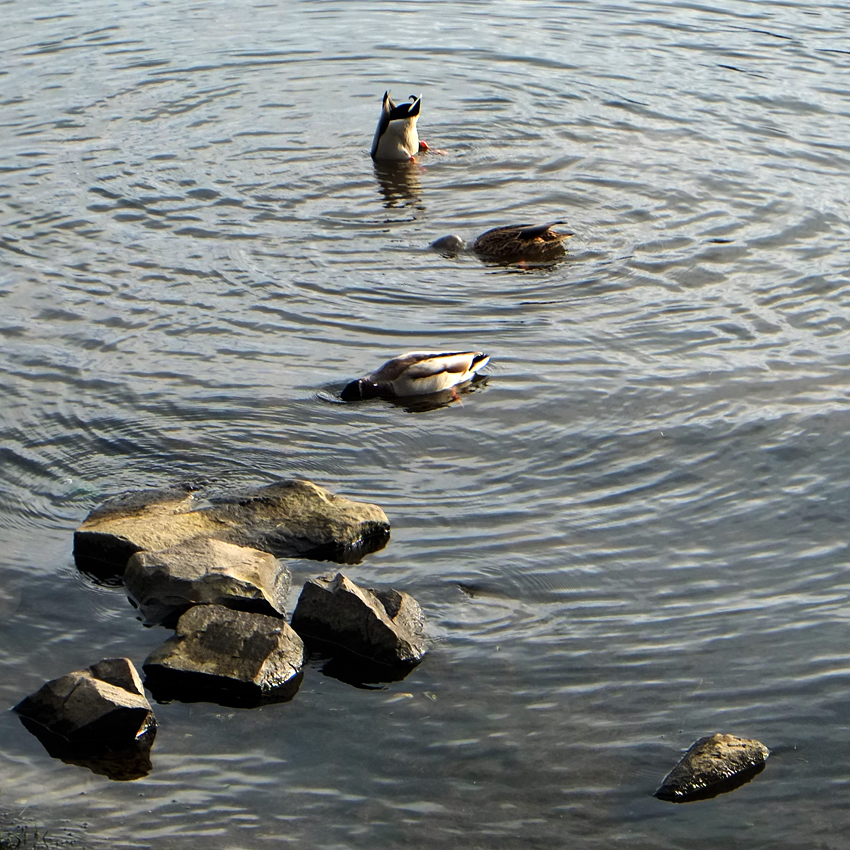 Migrating ducks were happy to dive for fish in the shallows.
Migrating ducks were happy to dive for fish in the shallows.
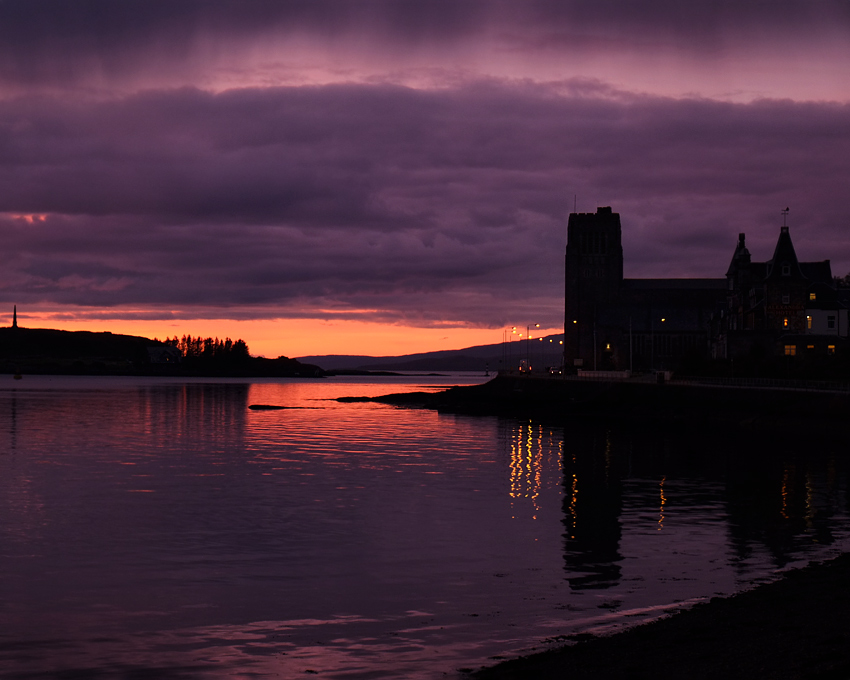 We crossed Scotland to the west coast and the town of Oban for another fantastic sunset. My wife loves oysters, and Oban has the best oysters in the world, she says.
We crossed Scotland to the west coast and the town of Oban for another fantastic sunset. My wife loves oysters, and Oban has the best oysters in the world, she says.
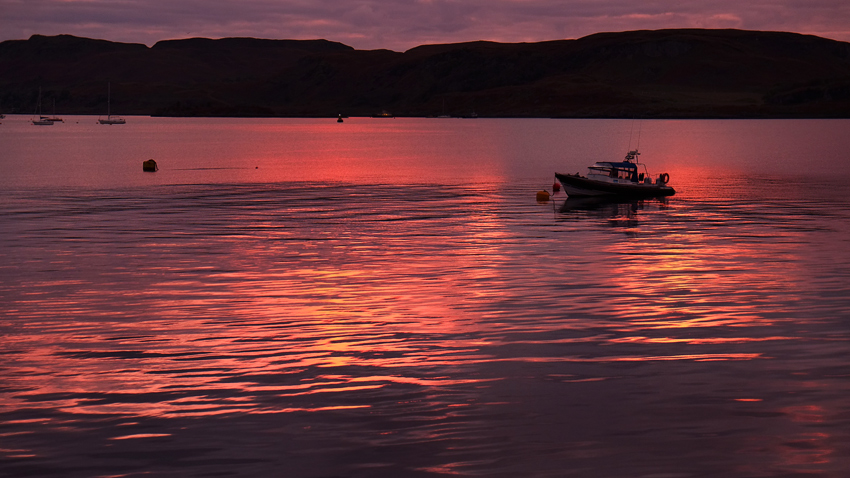 We strolled along the Oban Esplanade during a stunning sunset one evening.
We strolled along the Oban Esplanade during a stunning sunset one evening.
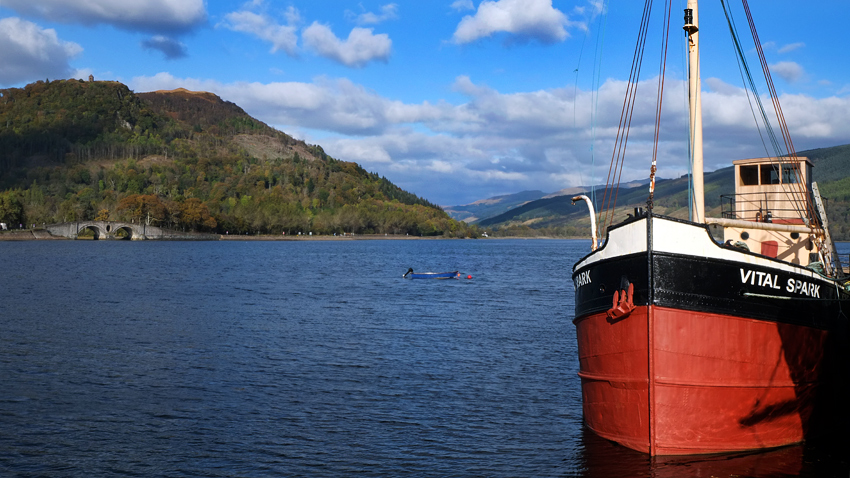 I had a wonderful amber ale with my seafood dinner in Oban, so we decided to see if we could find the brewery. Loch Fyne, and the Fyne Ales, were only a few hours away. We drove there and bought four cases of Jarl before heading on . . .
I had a wonderful amber ale with my seafood dinner in Oban, so we decided to see if we could find the brewery. Loch Fyne, and the Fyne Ales, were only a few hours away. We drove there and bought four cases of Jarl before heading on . . .
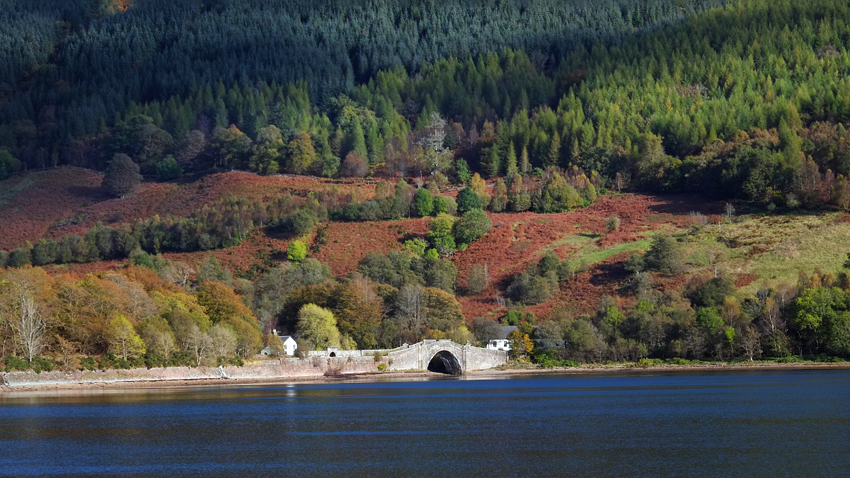 The bridge at the upper end of Loch Fyne.
The bridge at the upper end of Loch Fyne.
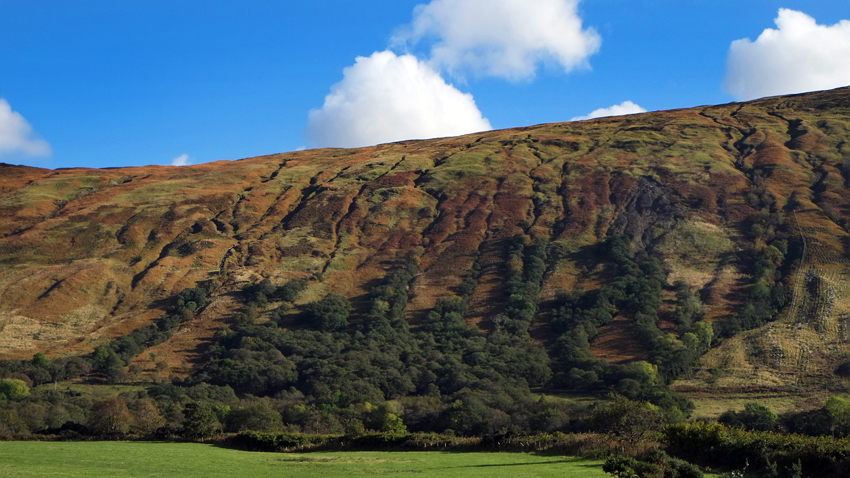 The autumn hills across Loch Fyne. We had great oysters near here too.
The autumn hills across Loch Fyne. We had great oysters near here too.
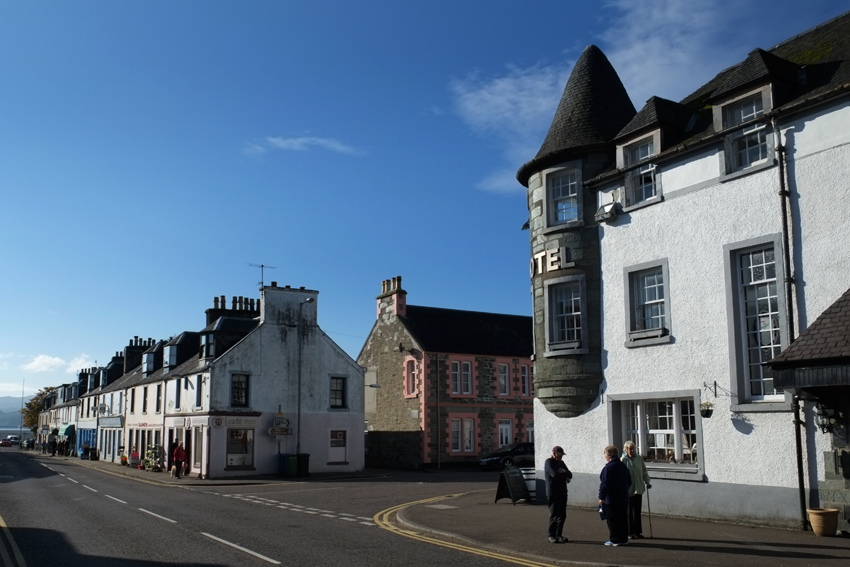 Based on a restaurant tip, we headed down to Argylll from Oban . . . to find a brewery . . . and this sweet village.
Based on a restaurant tip, we headed down to Argylll from Oban . . . to find a brewery . . . and this sweet village.
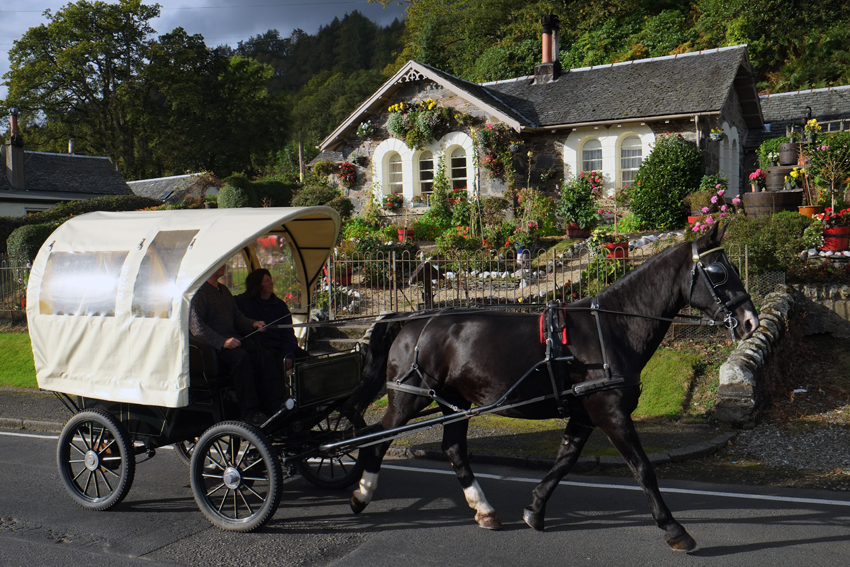 Our return route took us along Loch Lomond where we stayed overnight near the house-proud village of Aldochlay, before driving on to Glasgow.
Our return route took us along Loch Lomond where we stayed overnight near the house-proud village of Aldochlay, before driving on to Glasgow.
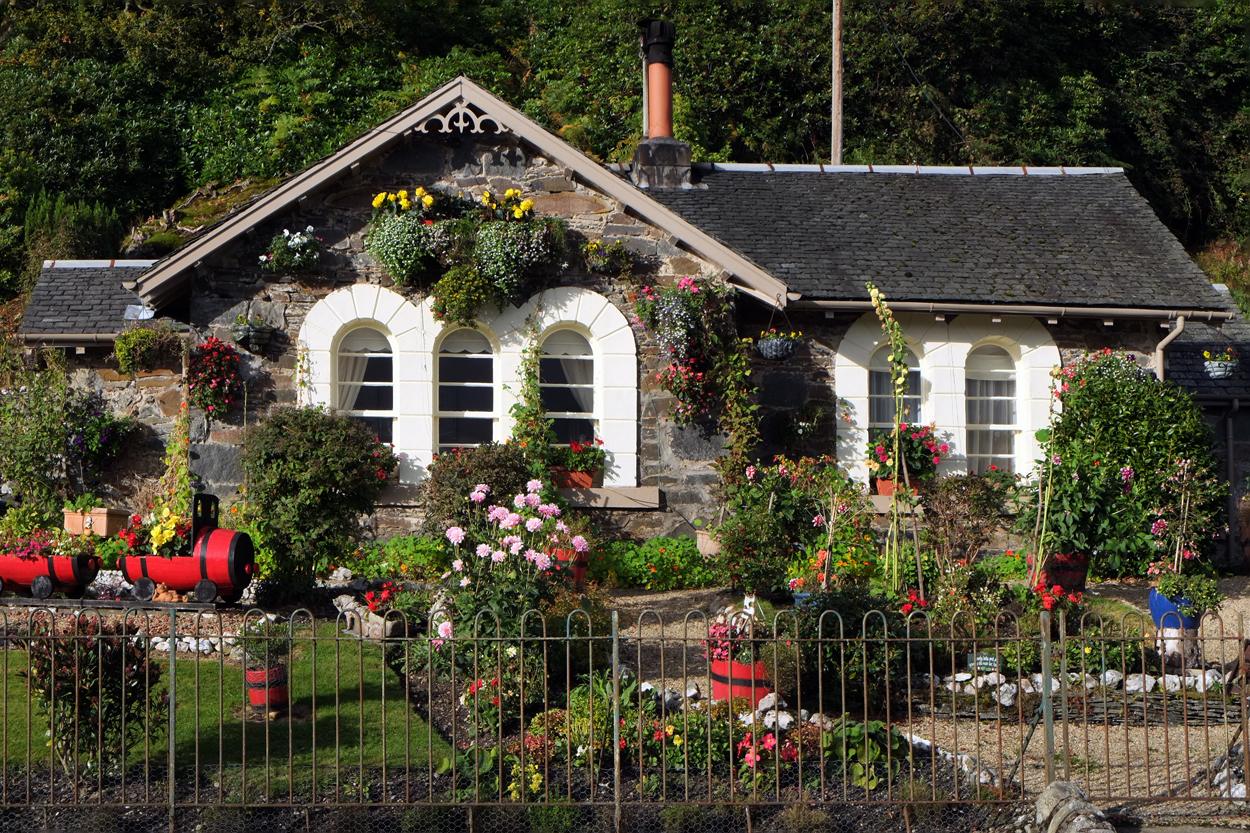 I can't resist another photo of this lovely cottage and garden on Loch Lomond.
I can't resist another photo of this lovely cottage and garden on Loch Lomond.
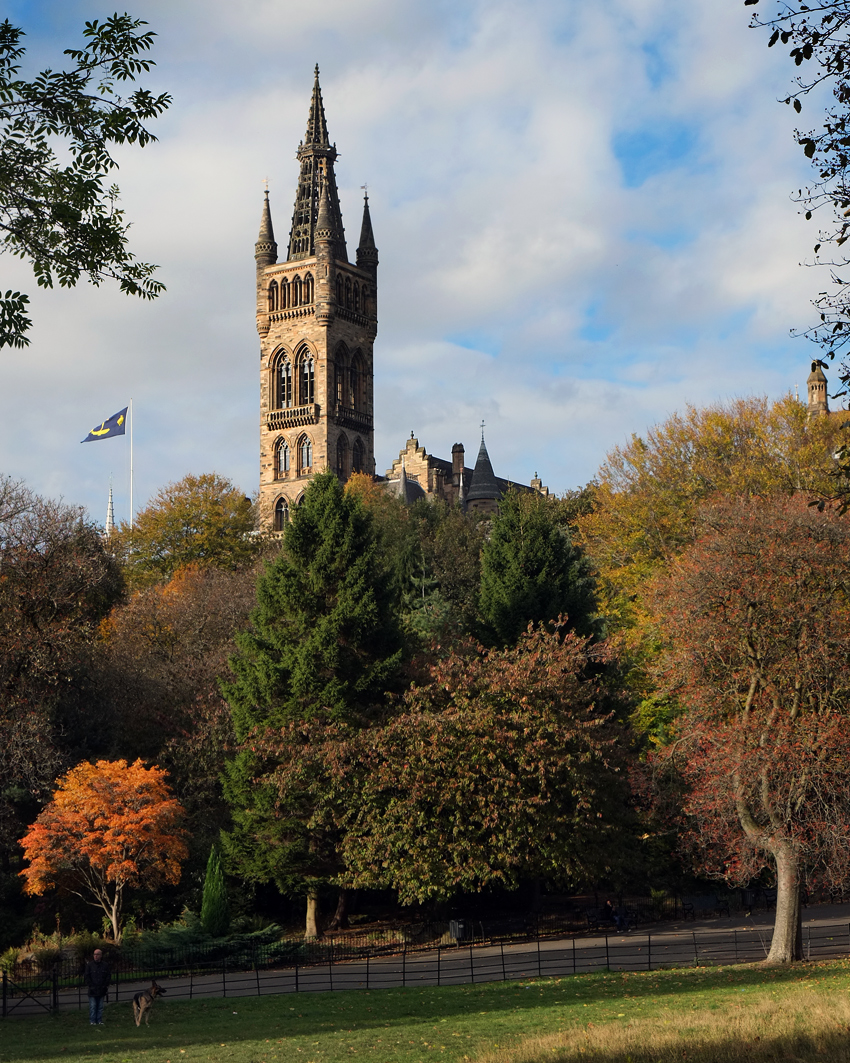 We stayed in Glasgow a few days before driving home to Aberdeen. We love Glasgow, a city of 2.5 million souls.
We stayed in Glasgow a few days before driving home to Aberdeen. We love Glasgow, a city of 2.5 million souls.
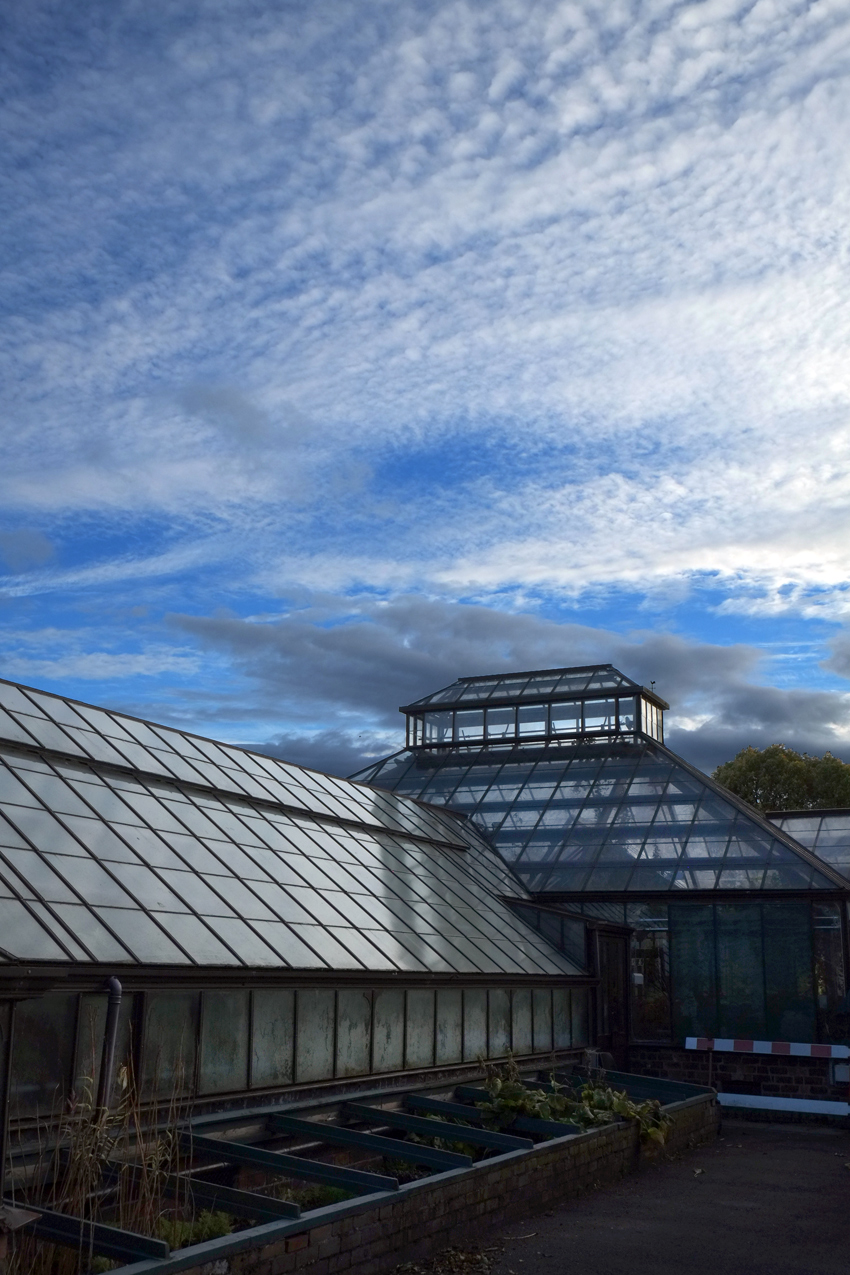 We like walking around Glasgow. There are many parks, but our favorite is the Glasgow Botanic Garden.
We like walking around Glasgow. There are many parks, but our favorite is the Glasgow Botanic Garden.
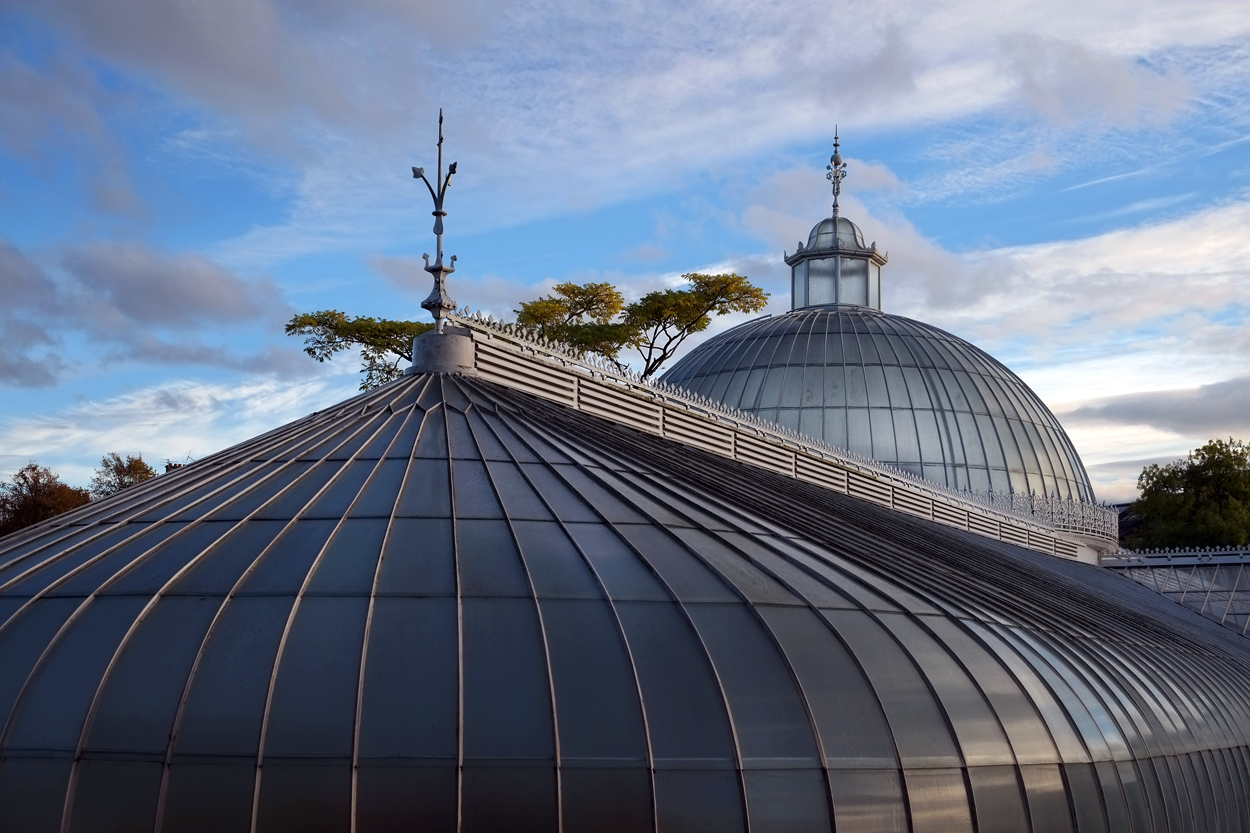 The greenhouses are fantastic.
The greenhouses are fantastic.
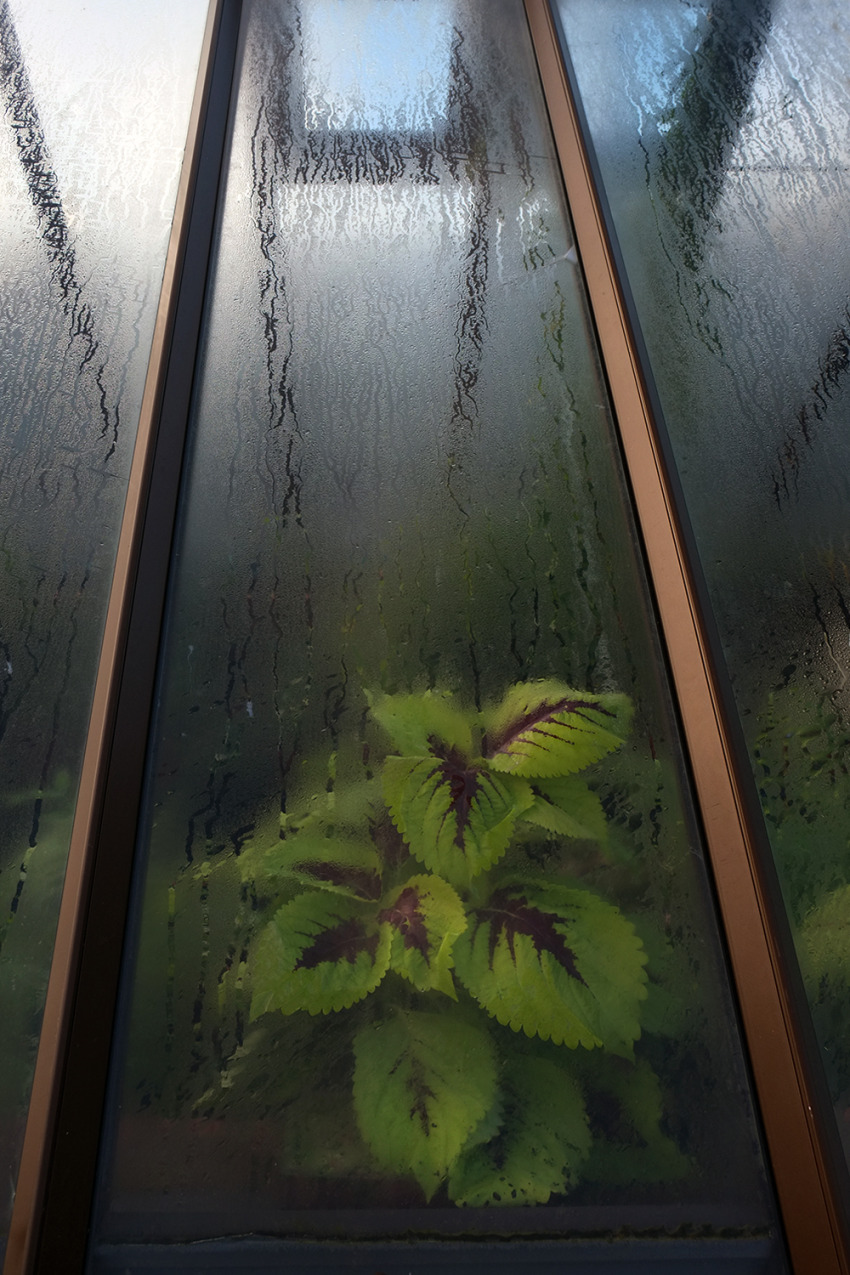 It's nice to visit the tropical houses . . . we miss the tropical plants and heat of Bangkok sometimes.
It's nice to visit the tropical houses . . . we miss the tropical plants and heat of Bangkok sometimes.
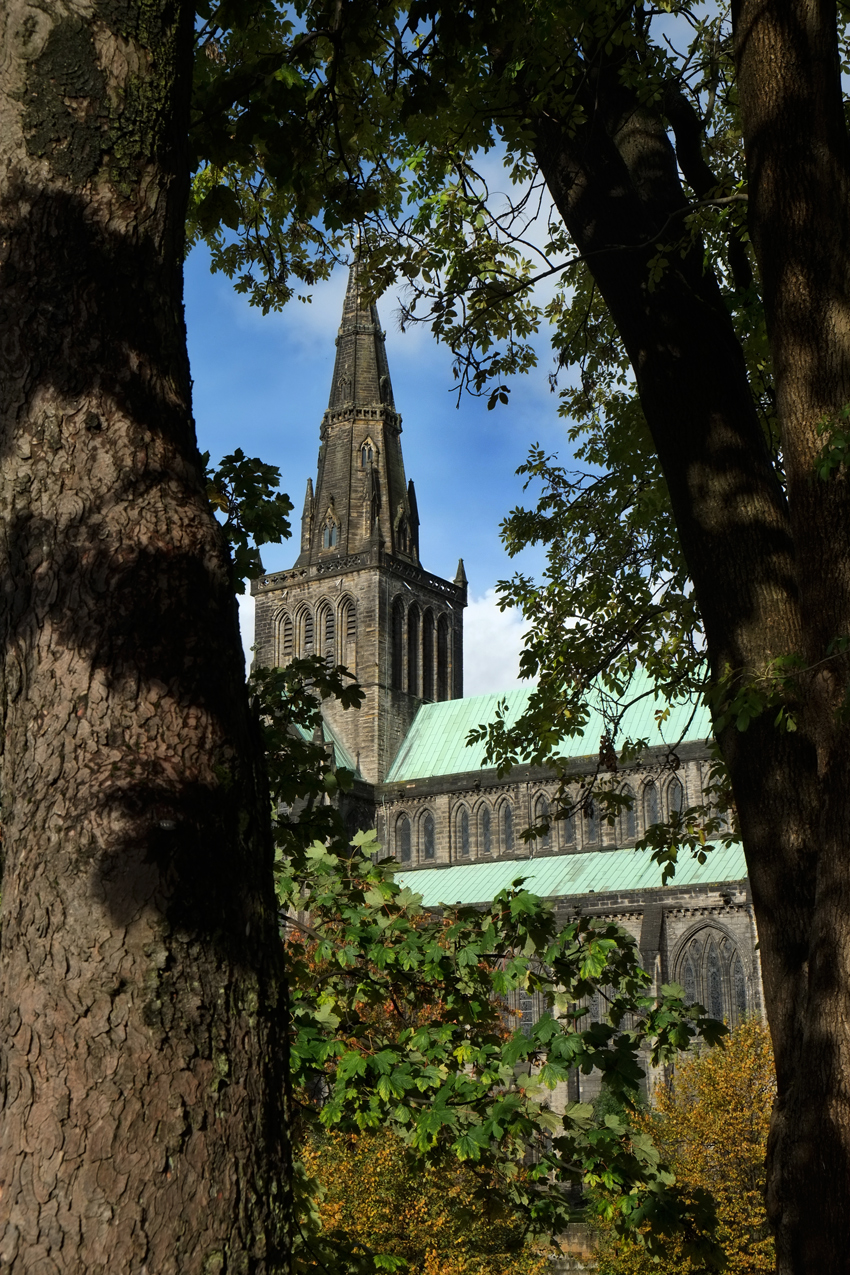 The 12th century Glasgow Cathedral is certainly worth a visit. "It is also one of the few Scottish medieval churches (and the only medieval cathedral on the Scottish mainland) to have survived the Reformation not unroofed."
The 12th century Glasgow Cathedral is certainly worth a visit. "It is also one of the few Scottish medieval churches (and the only medieval cathedral on the Scottish mainland) to have survived the Reformation not unroofed."
 It goes without saying that the interior of Glasgow Cathedral is a phantasmagoria of images, light and shadow.
It goes without saying that the interior of Glasgow Cathedral is a phantasmagoria of images, light and shadow.
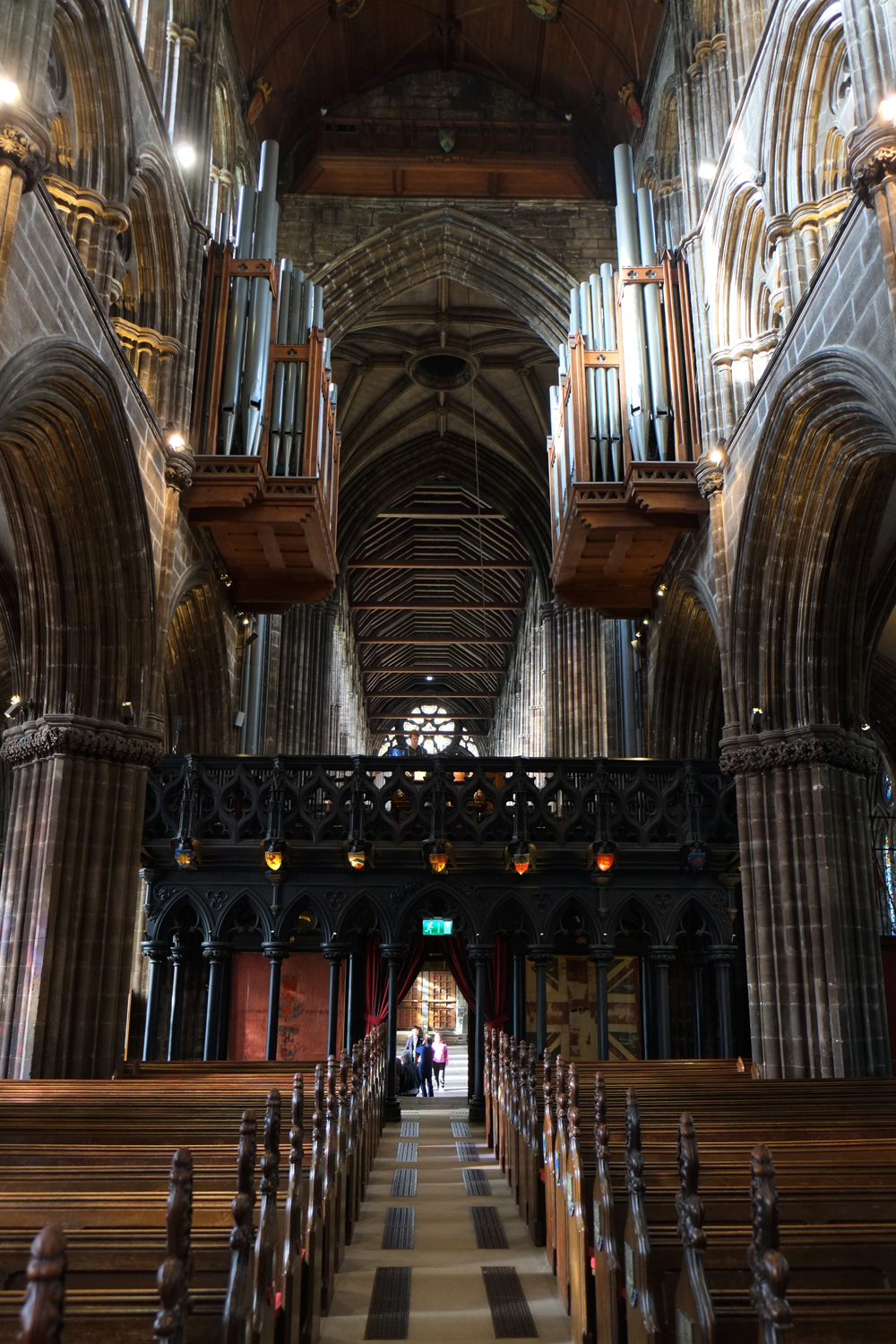 The pipe organ of Glasgow Cathedral.
The pipe organ of Glasgow Cathedral.
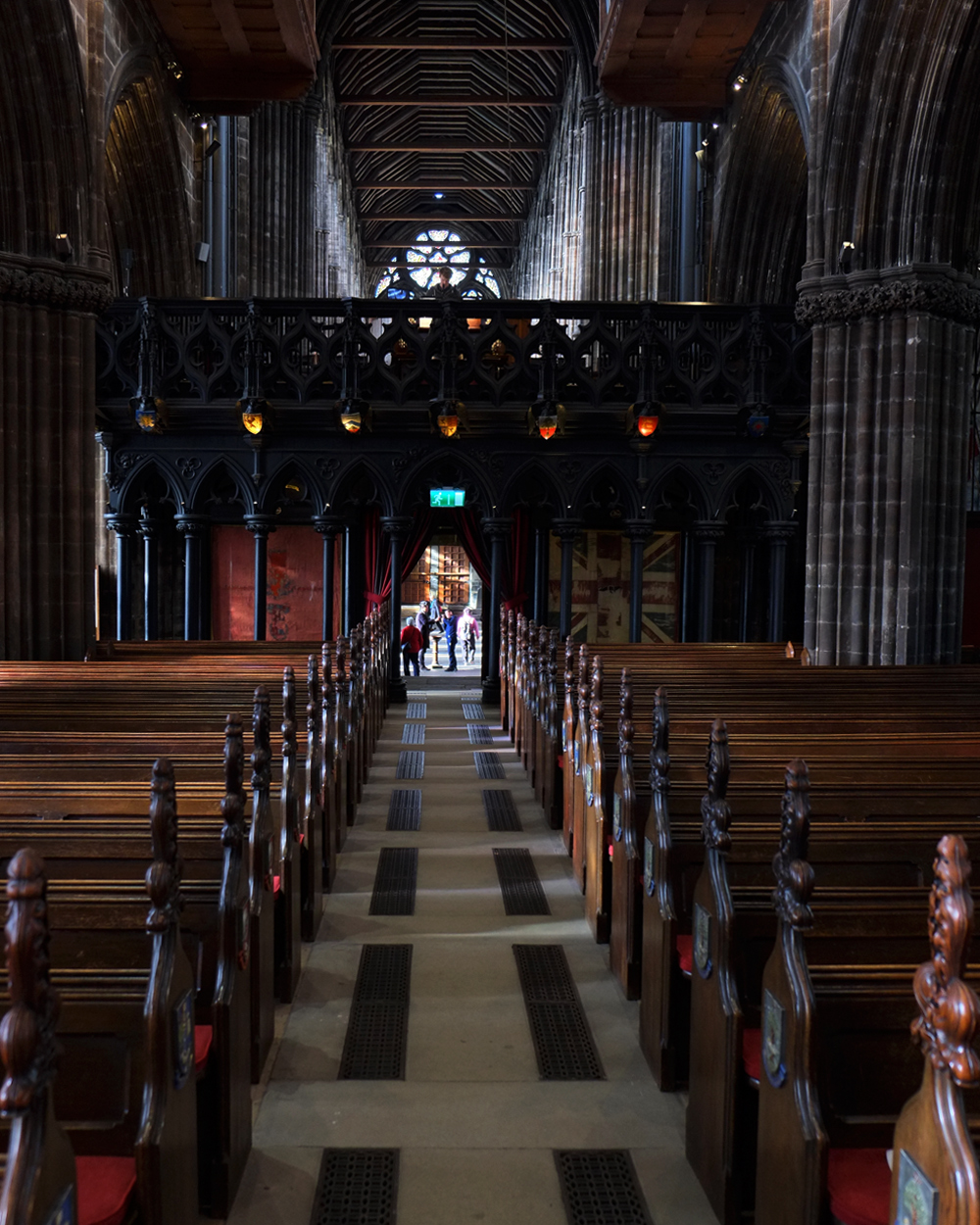 I could have stayed all day in this old space.
I could have stayed all day in this old space.
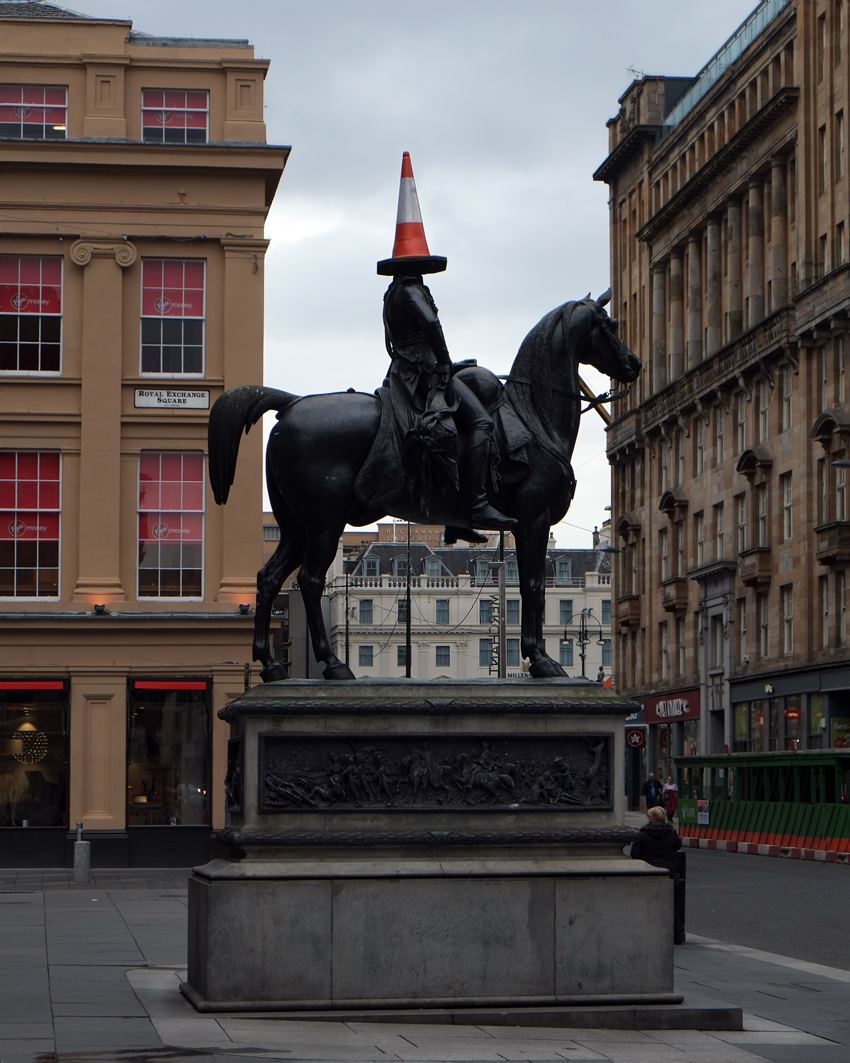 The Museum of Modern Art in Glasgow with the famous statue of the Duke of Wellington with the traffic cone . . . yes, it is an art installation.
The Museum of Modern Art in Glasgow with the famous statue of the Duke of Wellington with the traffic cone . . . yes, it is an art installation.
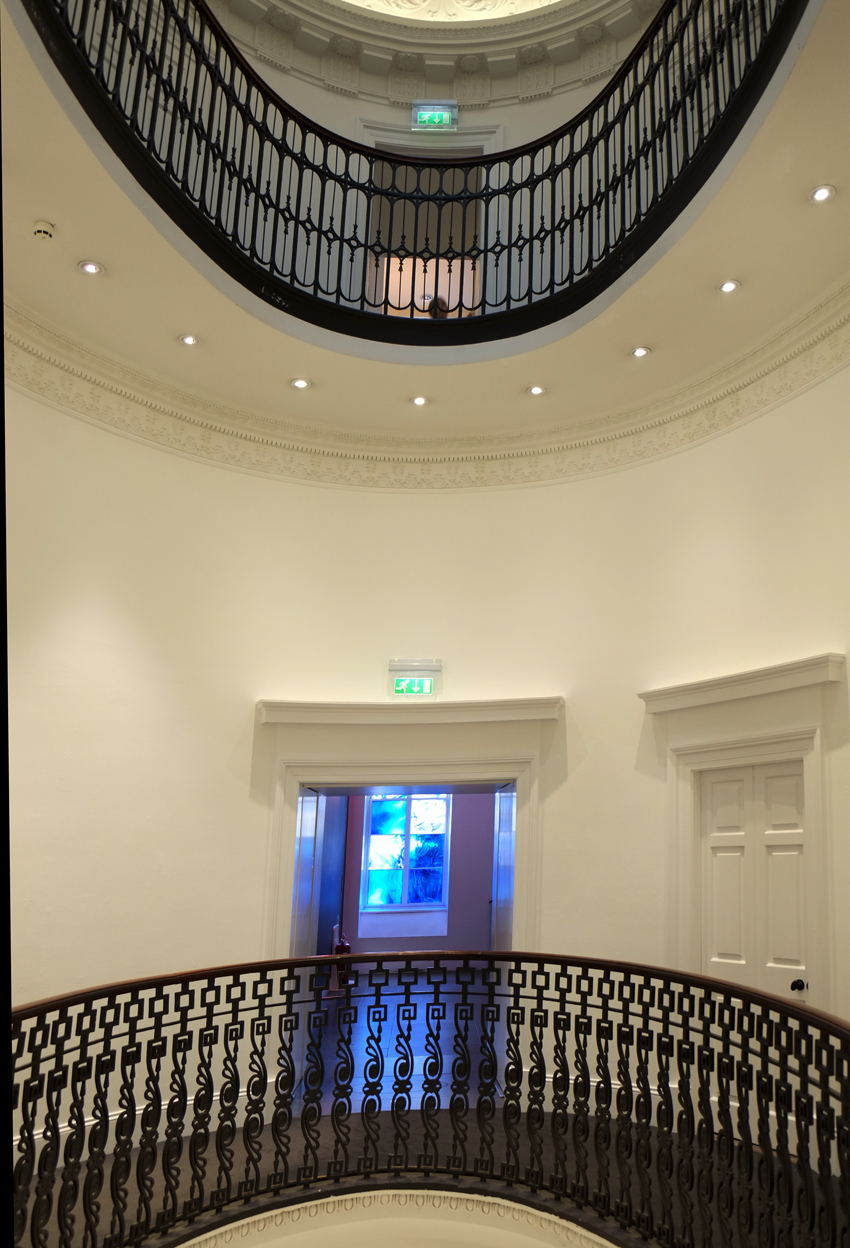 The interior of the Glasgow Museum of Modern Art.
The interior of the Glasgow Museum of Modern Art.
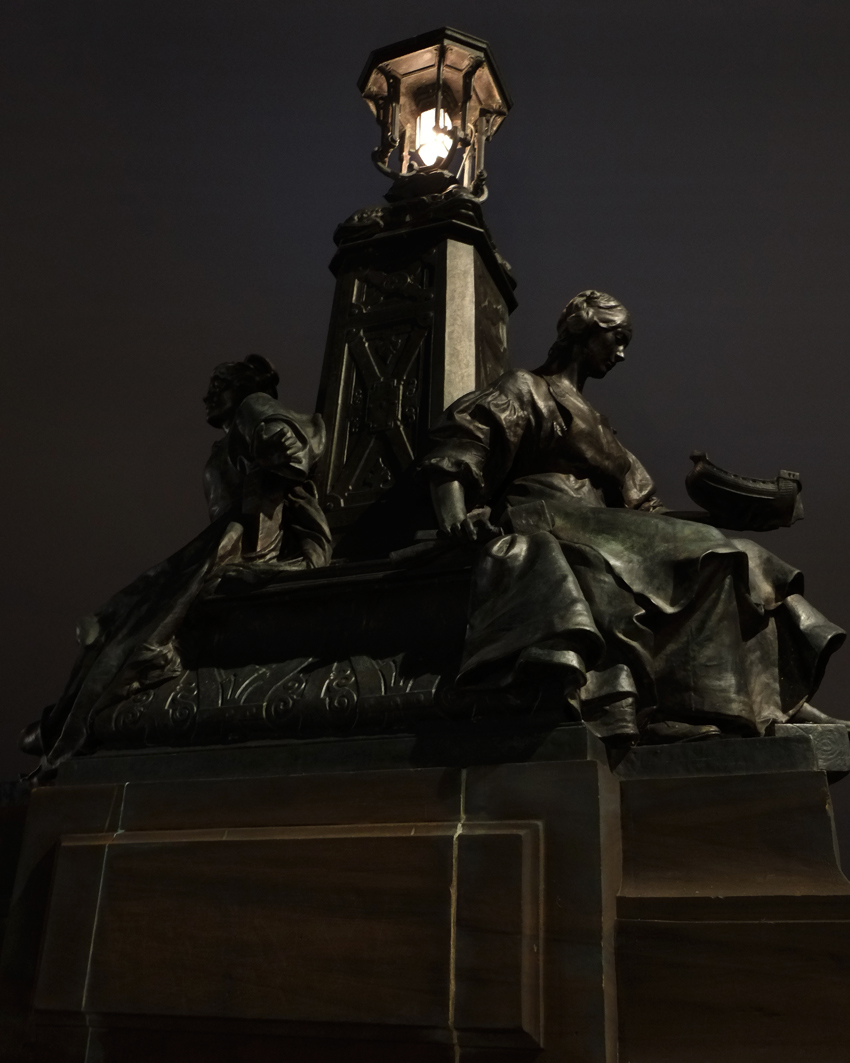 We love to walk around Glasgow. There is so much public art there . . . .
We love to walk around Glasgow. There is so much public art there . . . .
Thailand Photos: A Study of Splash Spirits
 Saturday, January 23, 2016 at 9:07PM
Saturday, January 23, 2016 at 9:07PM  On my recent vacation back home in Thailand I took a walk along the Gulf of Thailand shore to take some seascape shots.
On my recent vacation back home in Thailand I took a walk along the Gulf of Thailand shore to take some seascape shots.
 I took a number of photos of the low surf crashing against a retaining wall. As I zoomed my camera view screen to see if it was a clear shot, I noticed something interesting . . . .
I took a number of photos of the low surf crashing against a retaining wall. As I zoomed my camera view screen to see if it was a clear shot, I noticed something interesting . . . .
 . . . there were astounding patterns and forms in the splashes.
. . . there were astounding patterns and forms in the splashes.
 Each wave splash created an ethereal and aesthetic world that passed with the gravity it had defied.
Each wave splash created an ethereal and aesthetic world that passed with the gravity it had defied.
 These were not large phenomena, maybe only a foot or two high.
These were not large phenomena, maybe only a foot or two high.
 But I was mesmurized by their fleeting beauty.
But I was mesmurized by their fleeting beauty.
 Patterns in patterns, shapes within shapes.
Patterns in patterns, shapes within shapes.
 Fascinating.
Fascinating.
 Some of the captures were suitable for artistic post-processing, including a black and white study:
Some of the captures were suitable for artistic post-processing, including a black and white study:
 [All photos captured with a Fuji X-Ti and 56mm f1.2 lens]
[All photos captured with a Fuji X-Ti and 56mm f1.2 lens]
